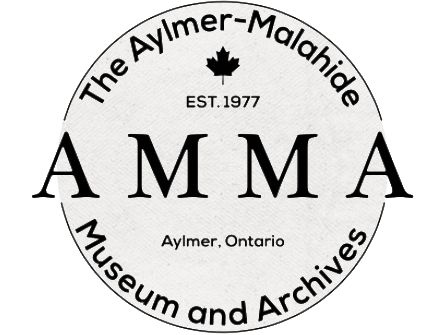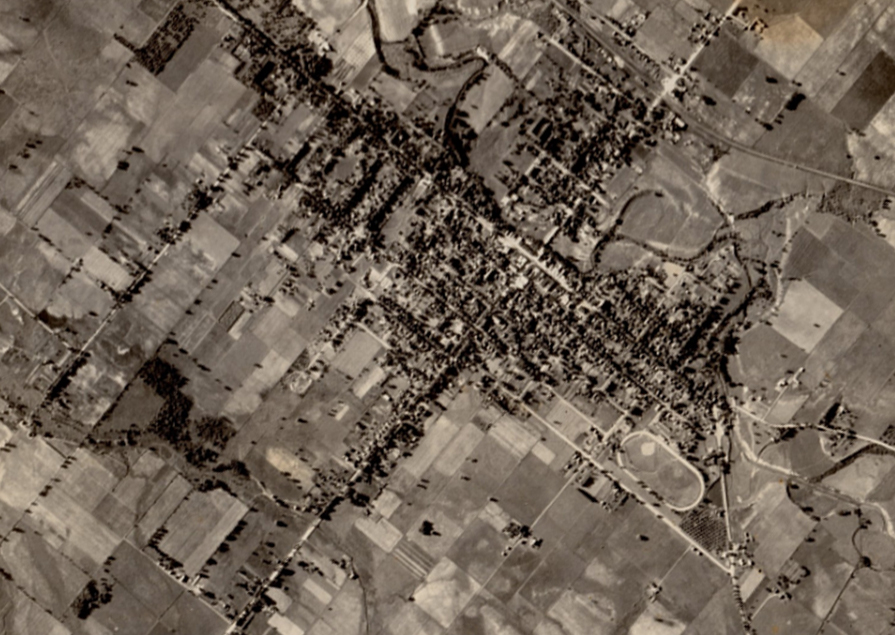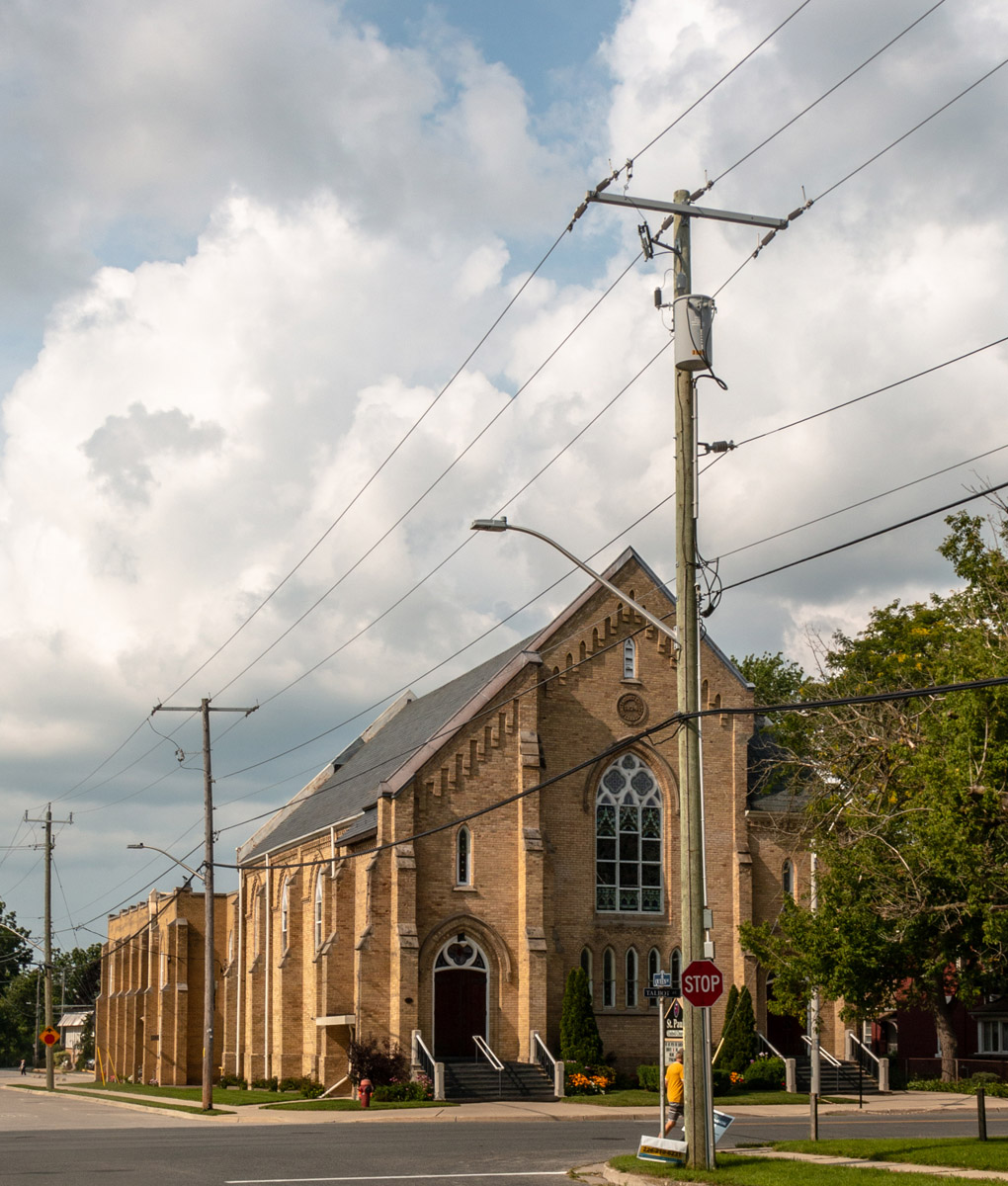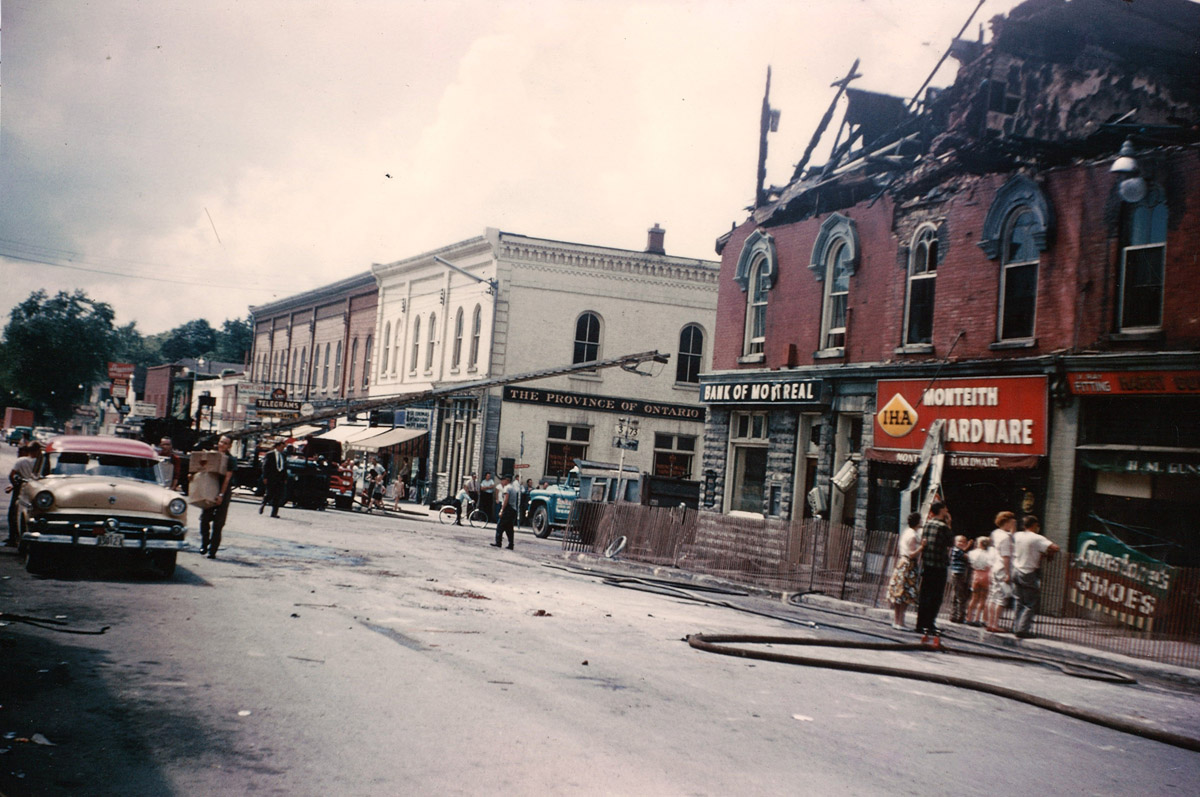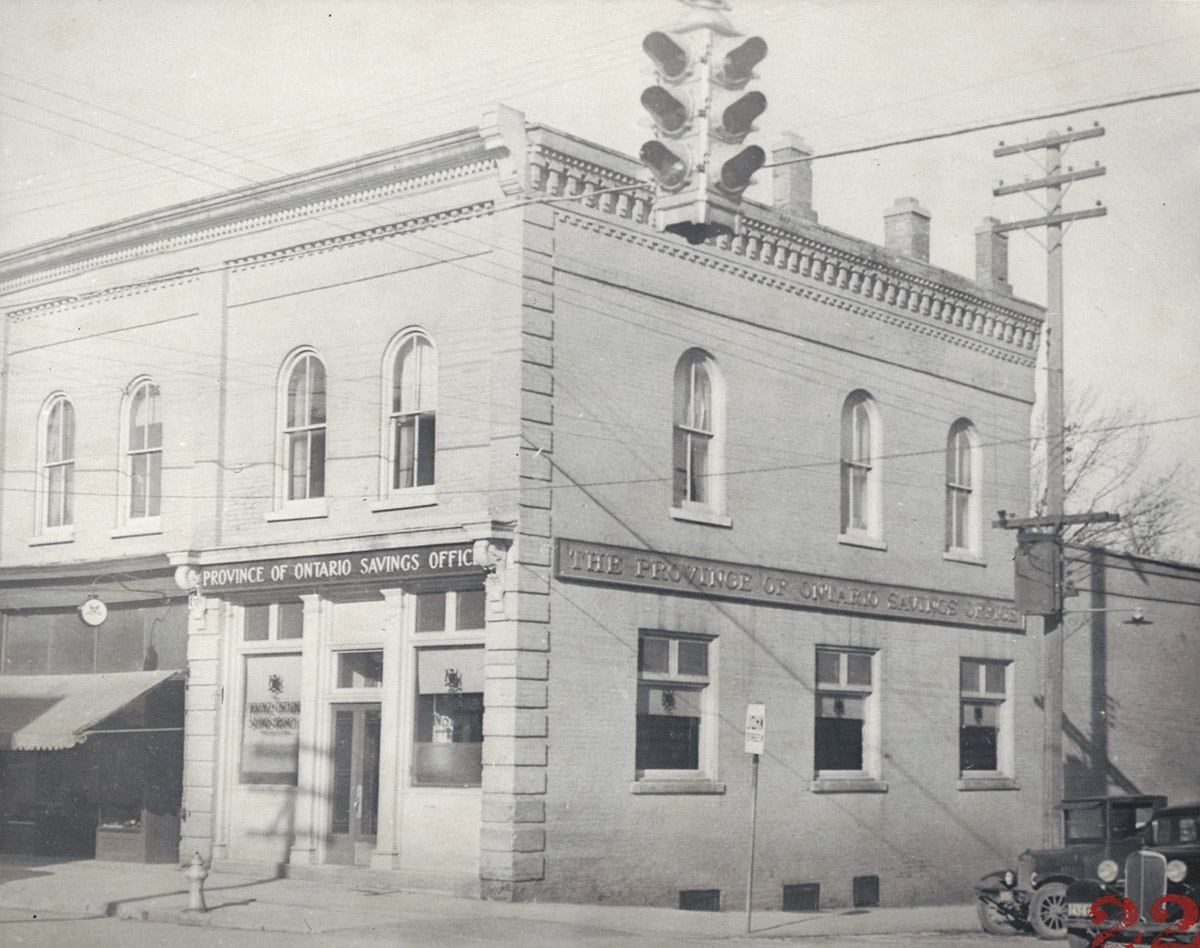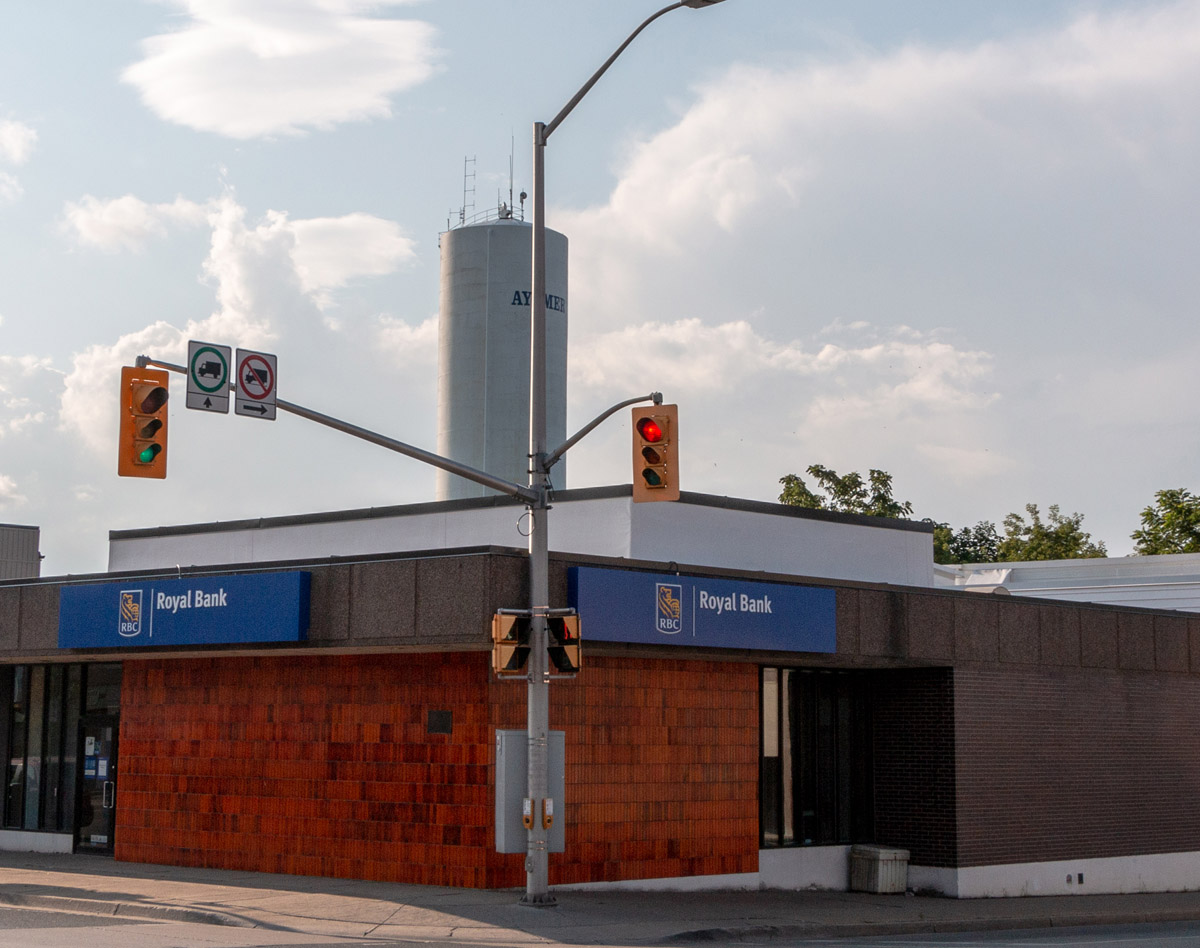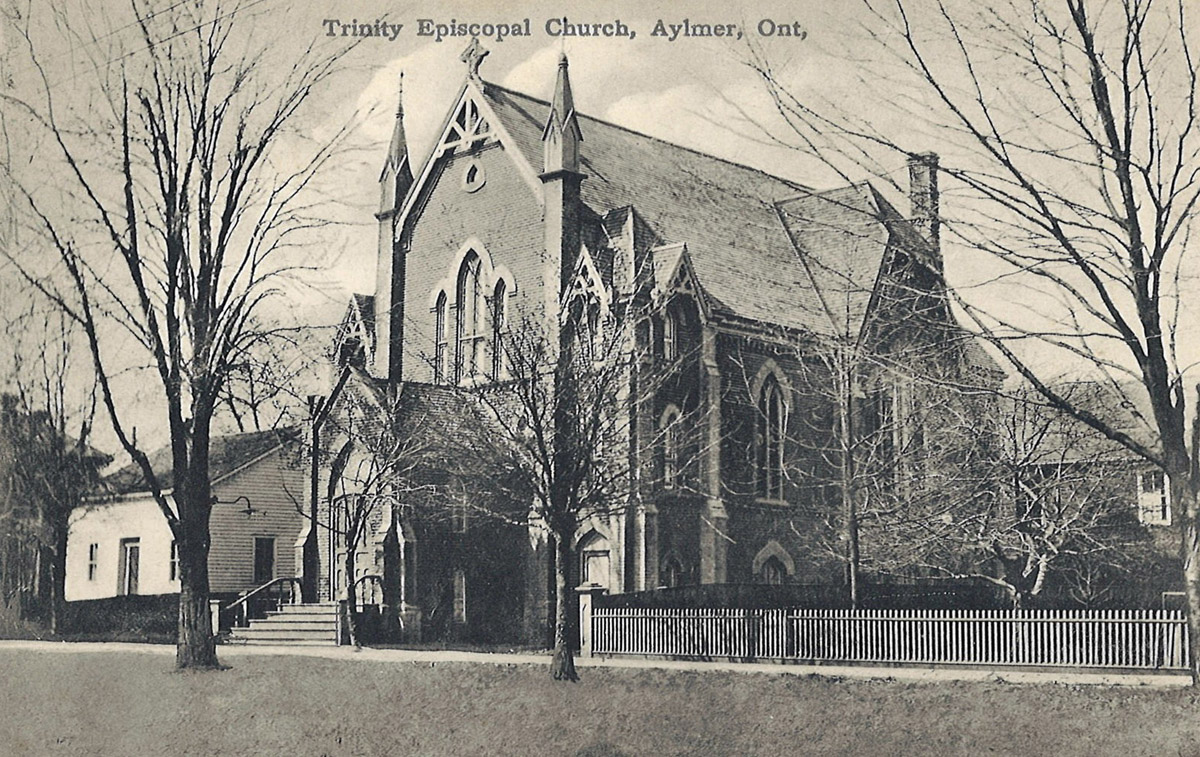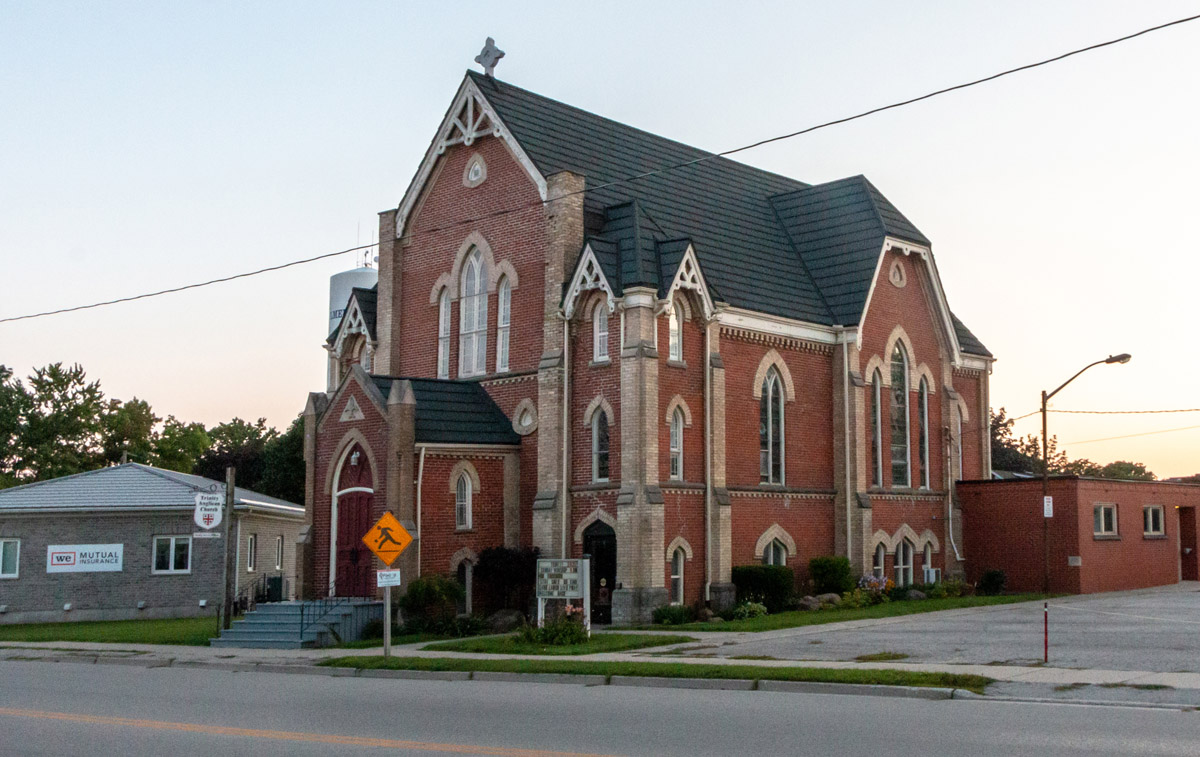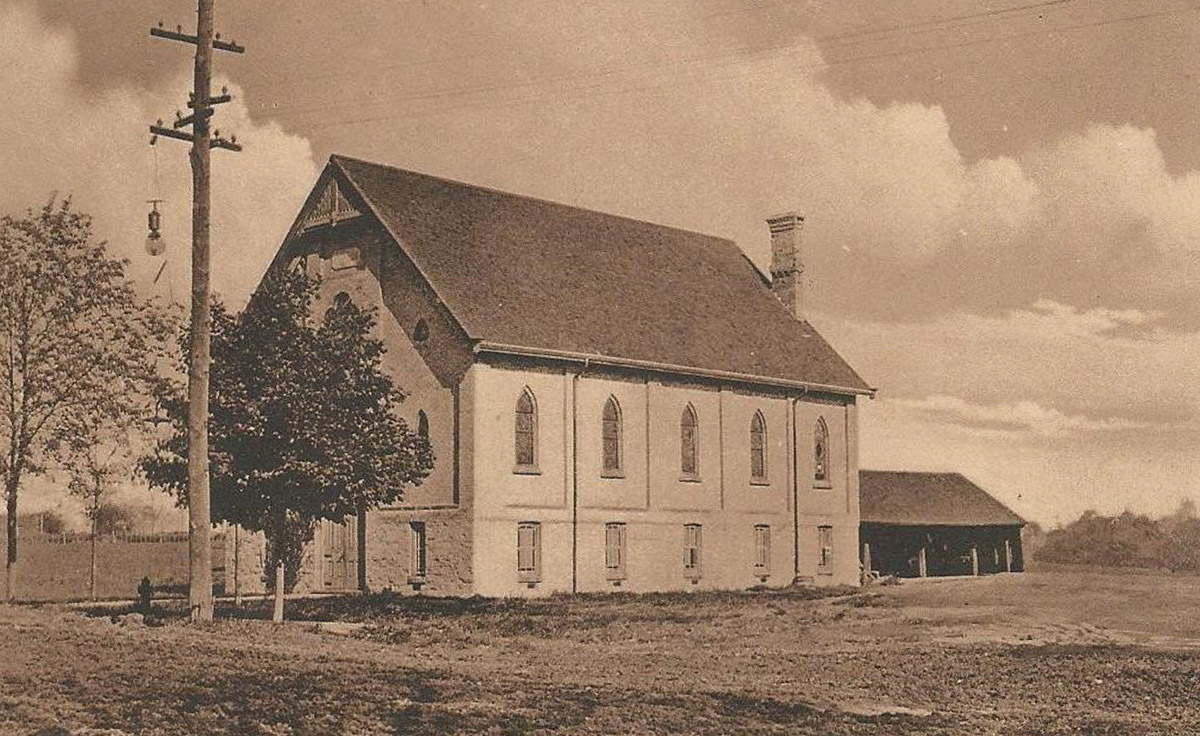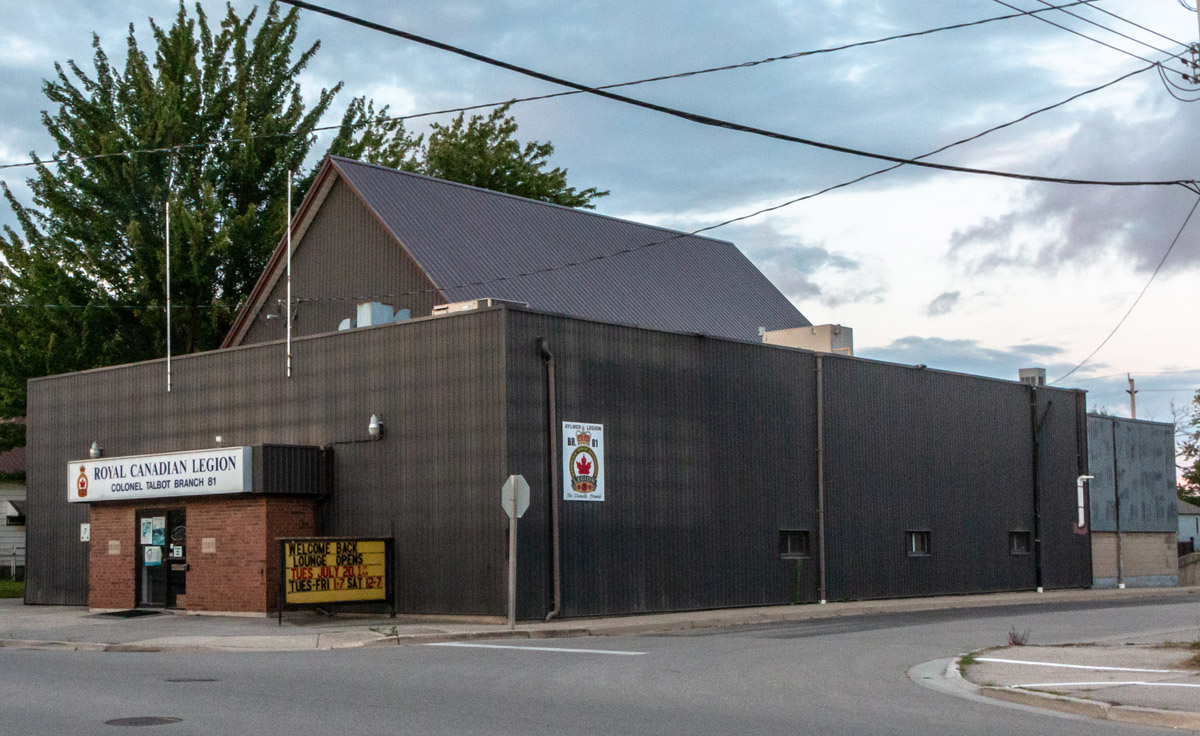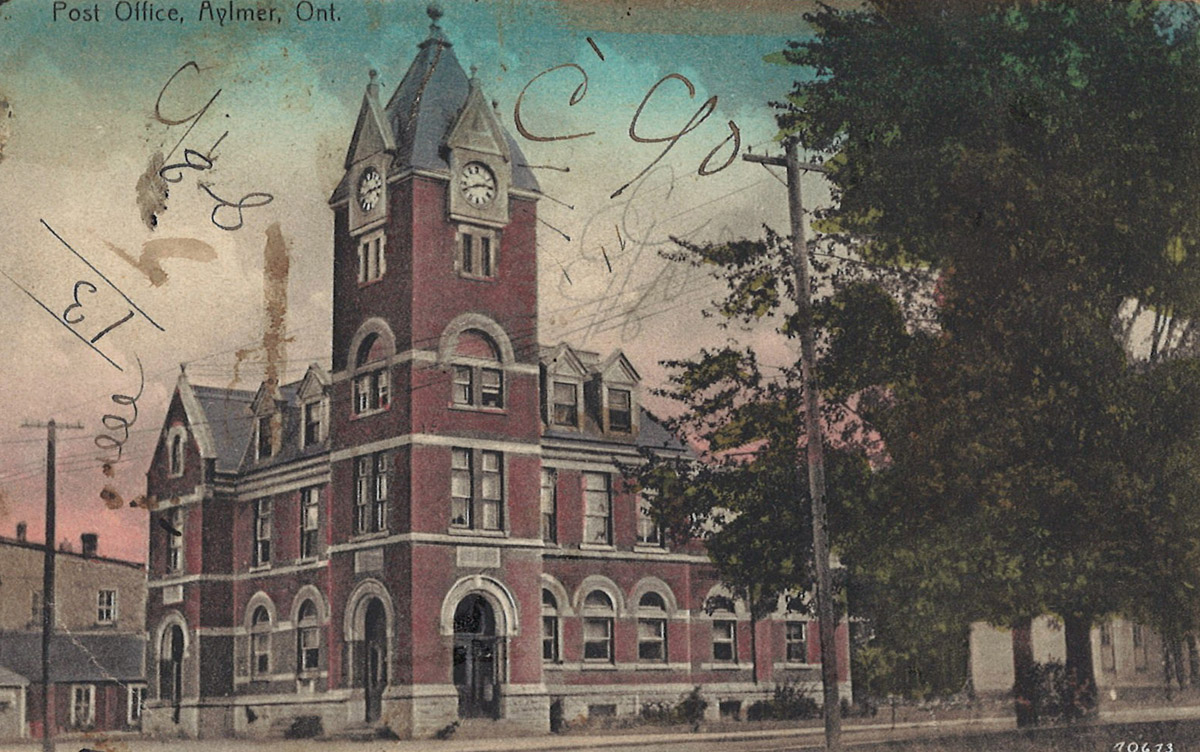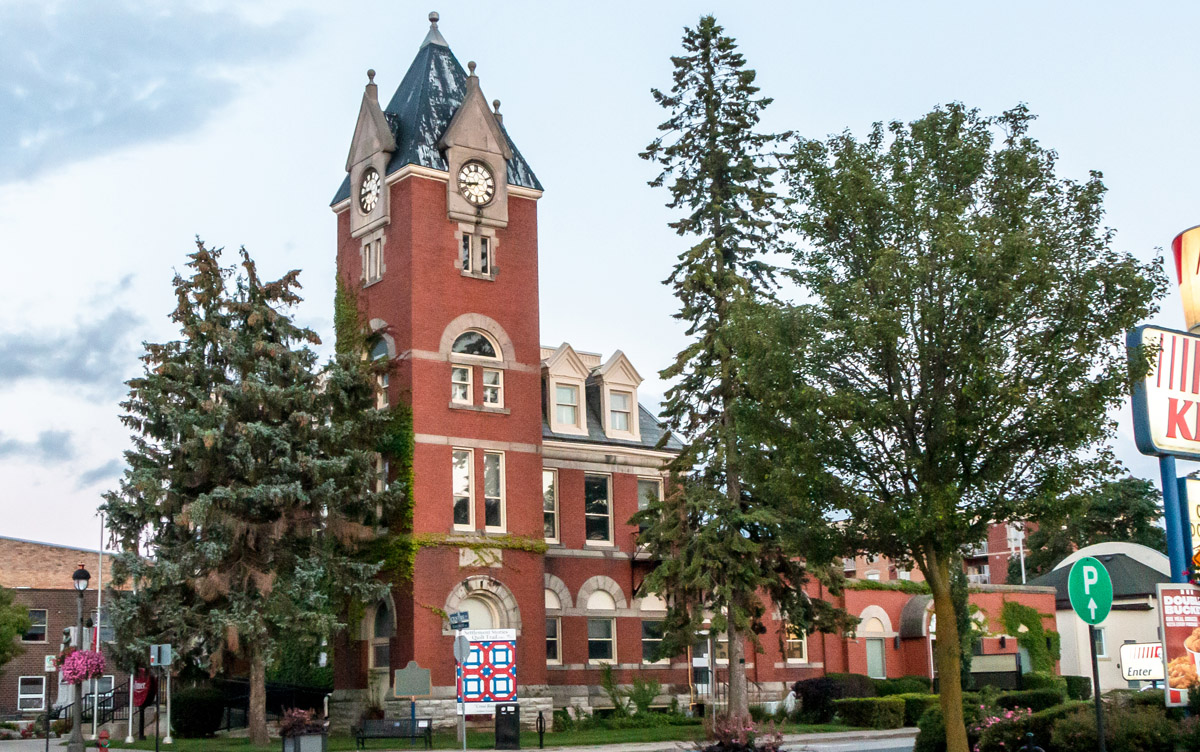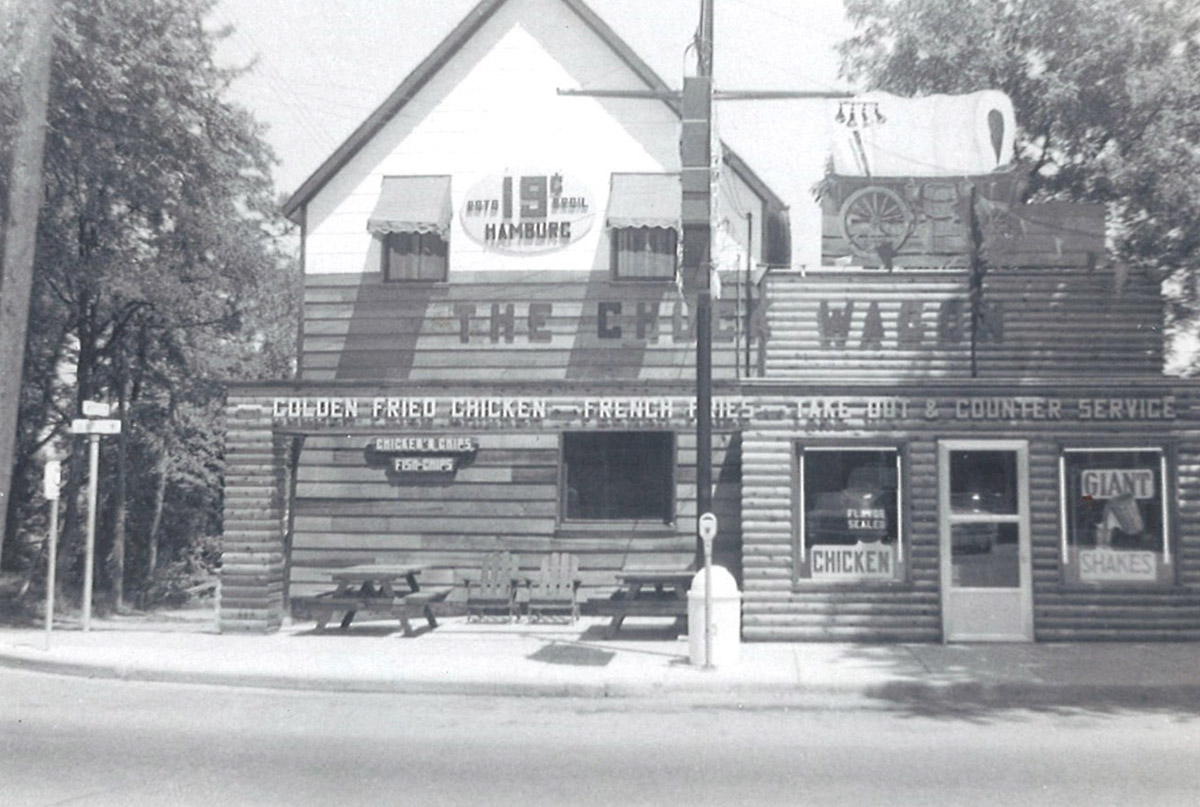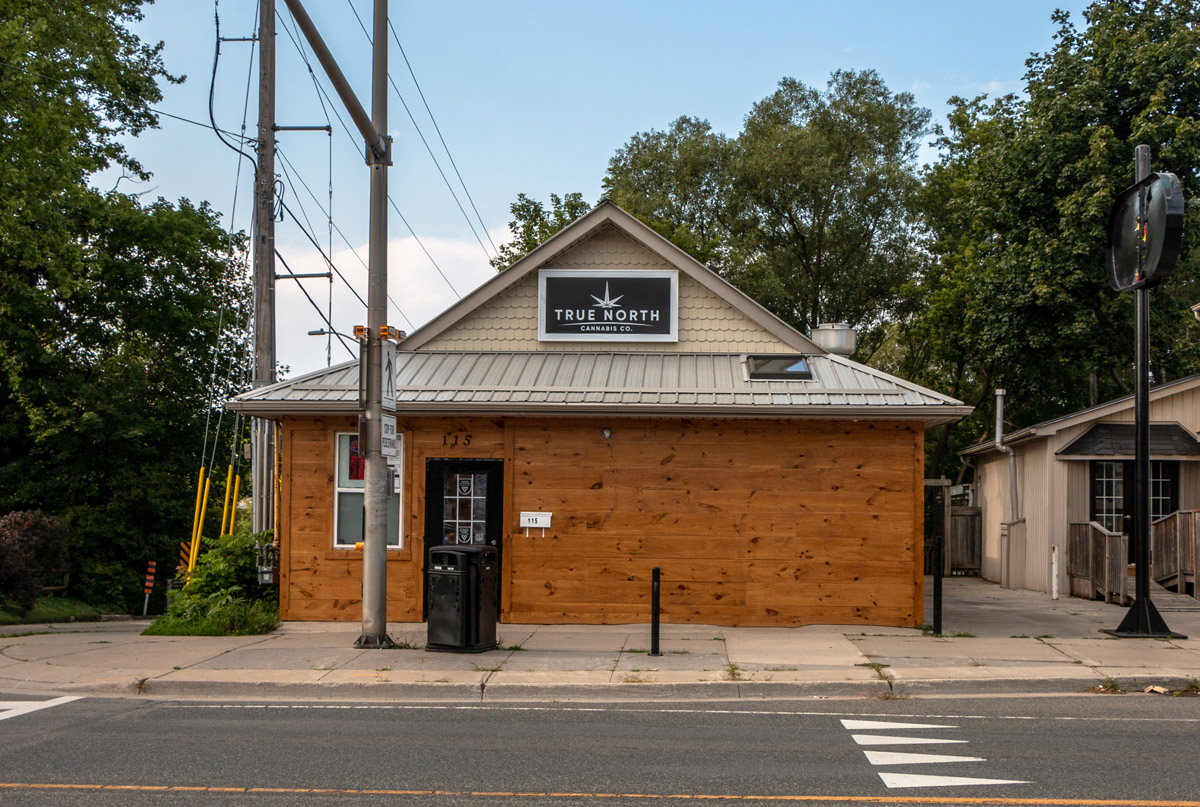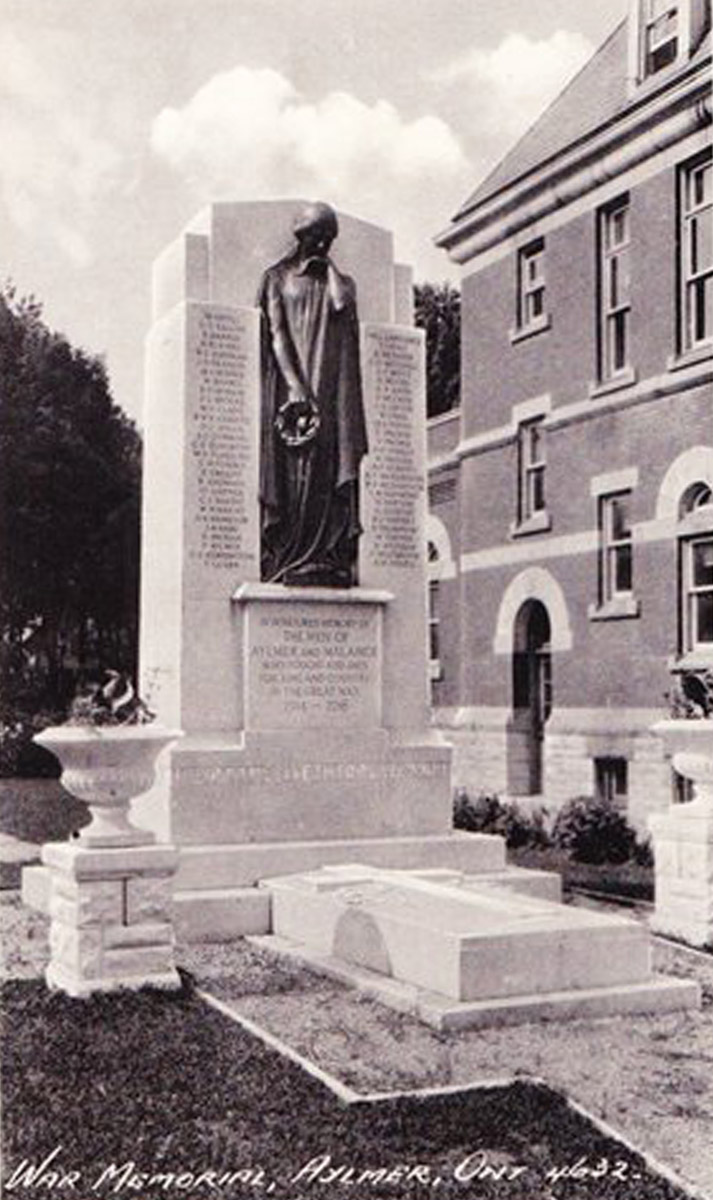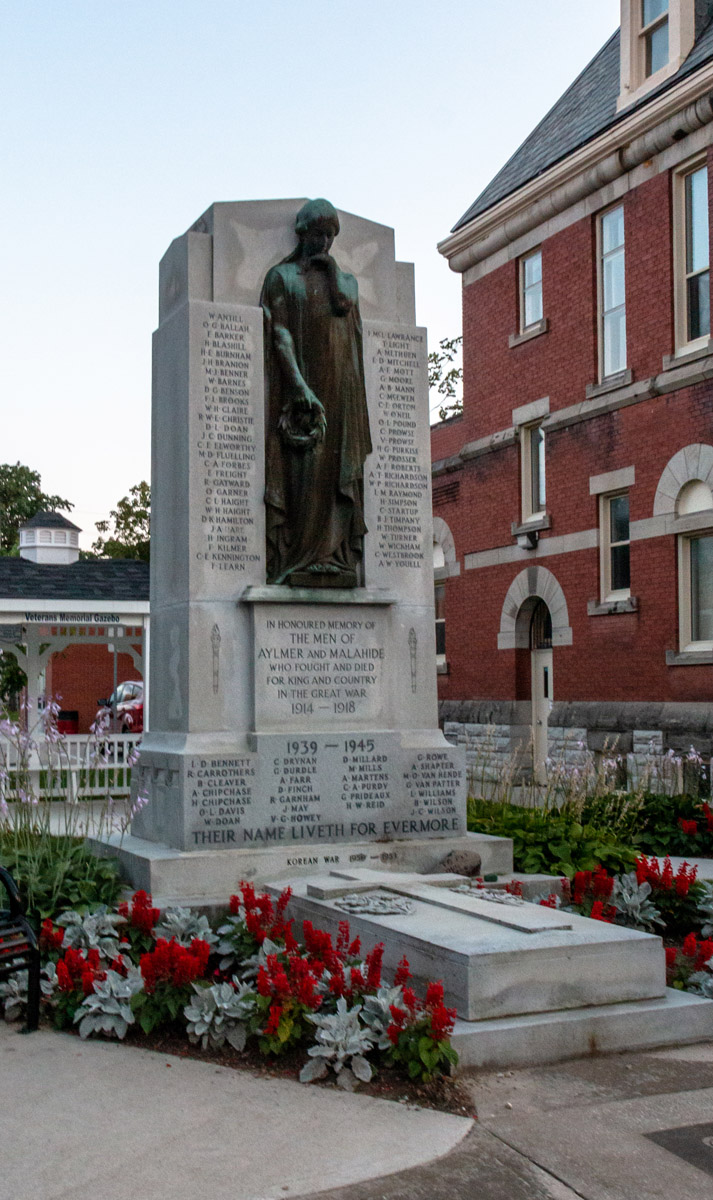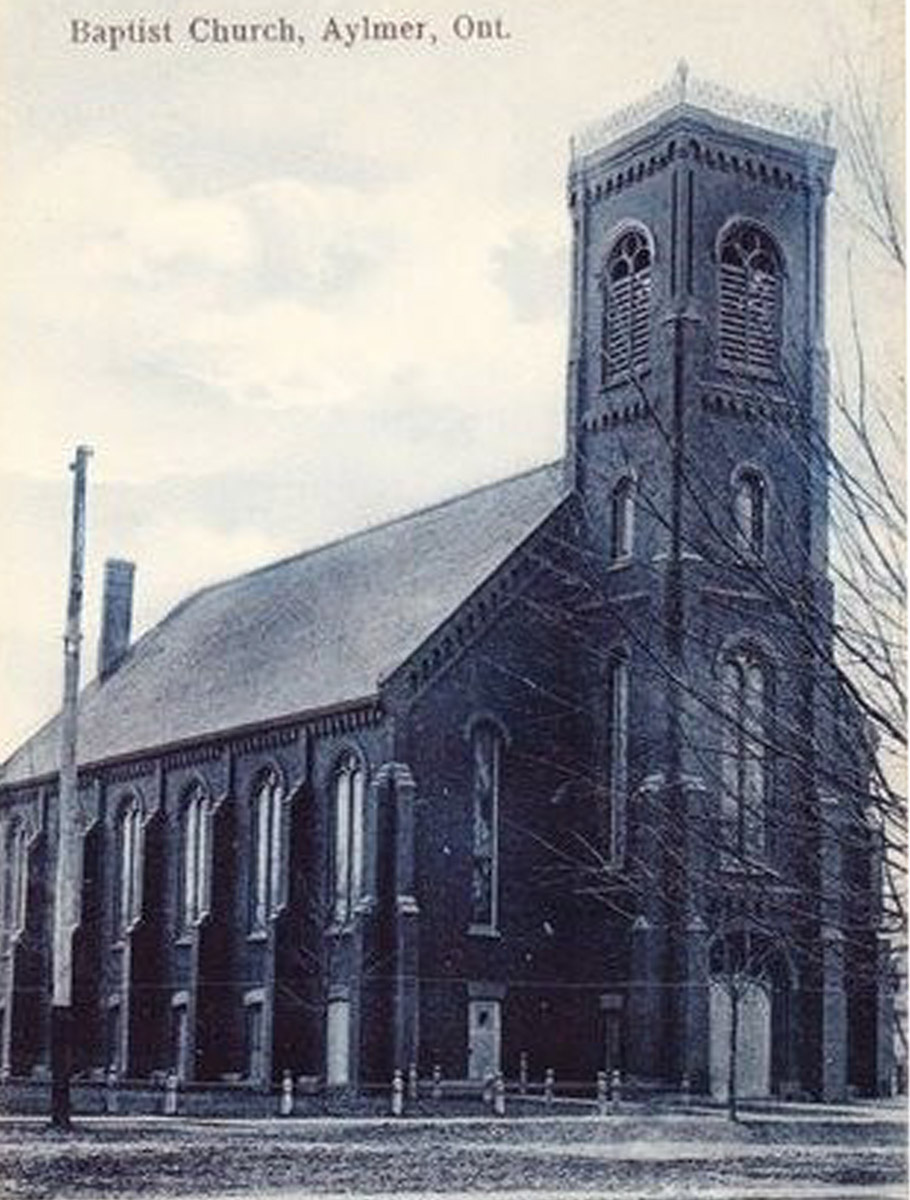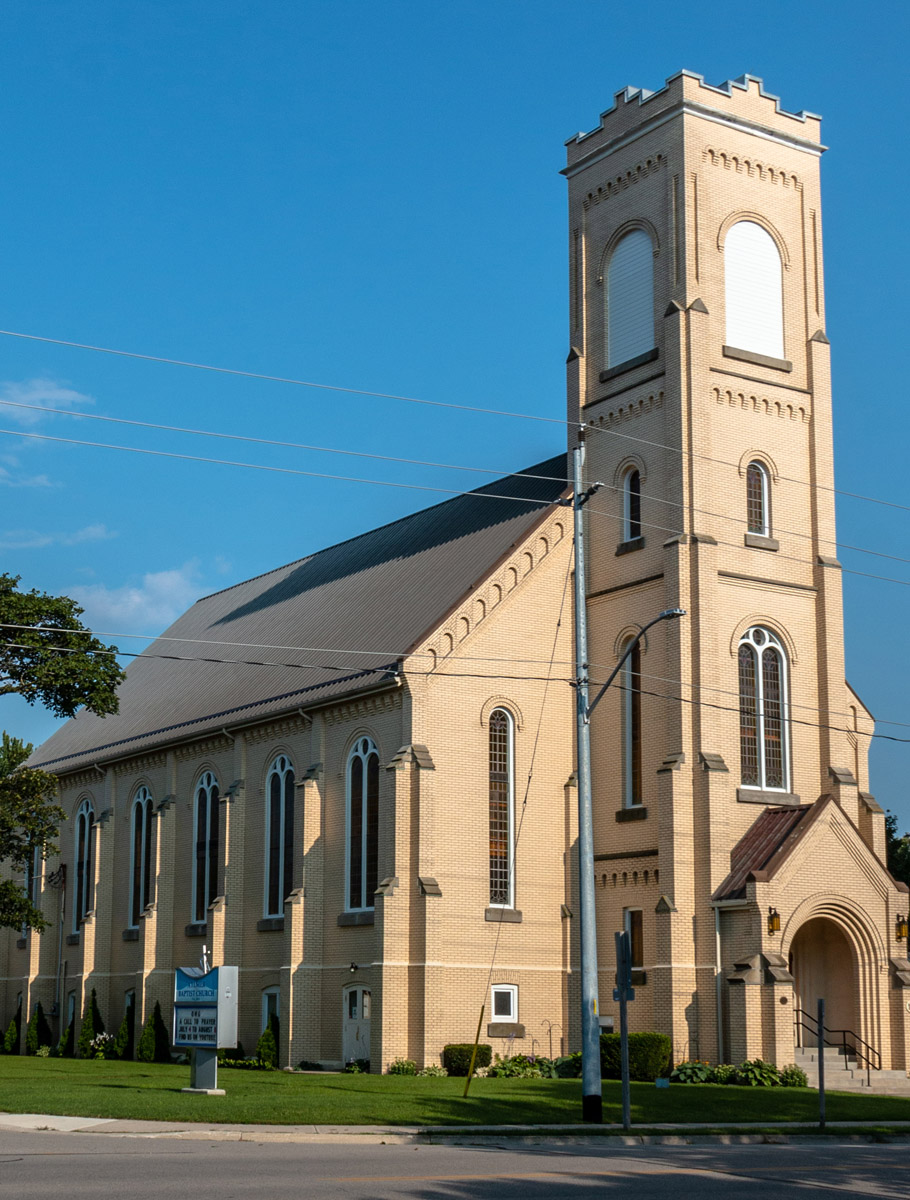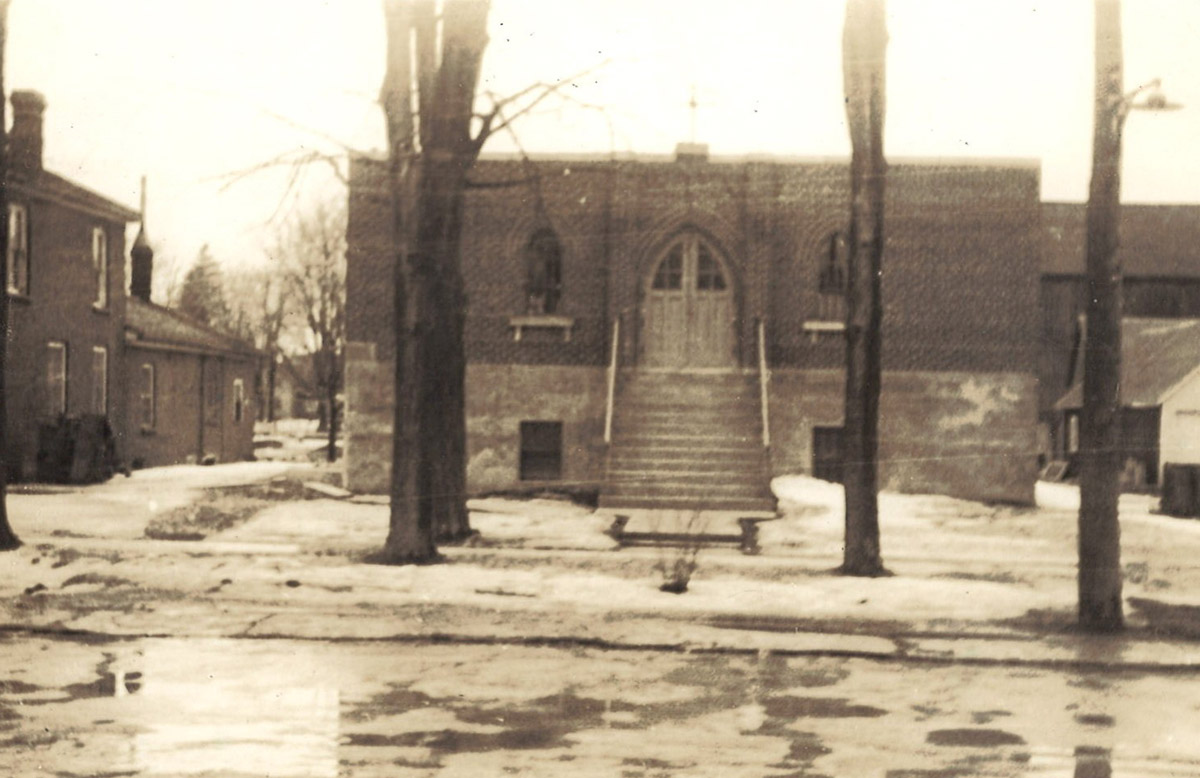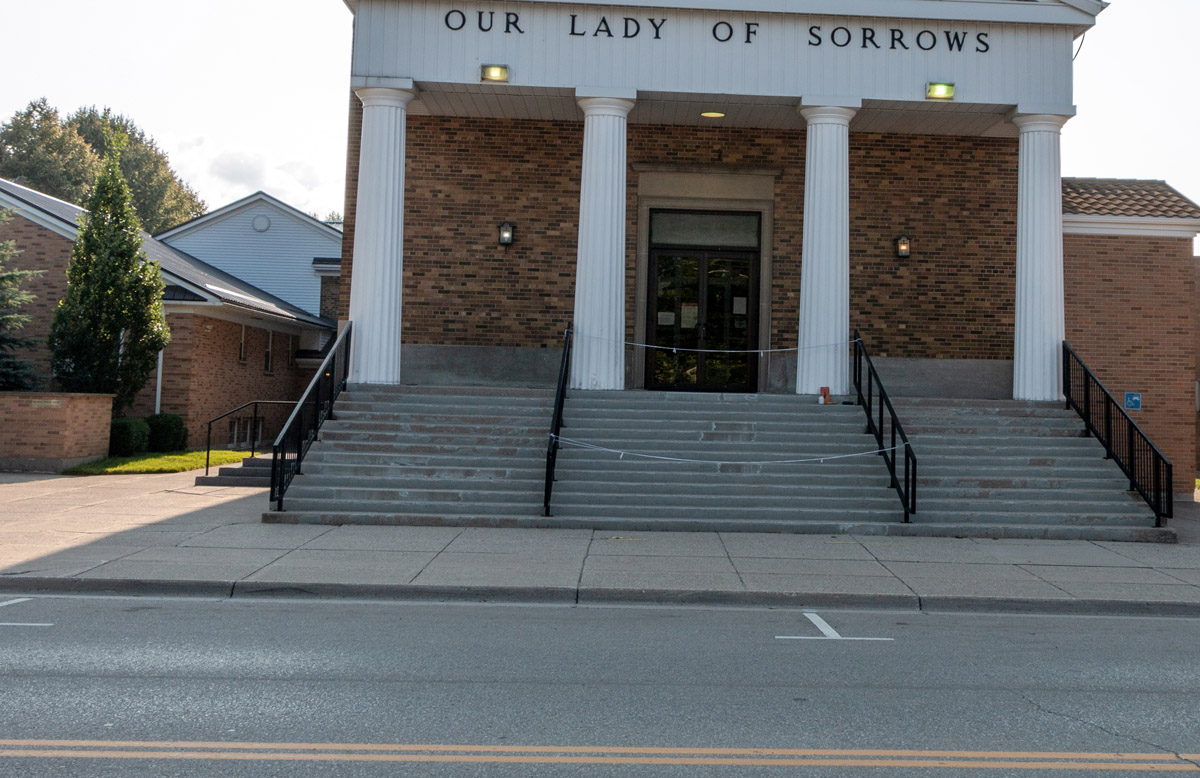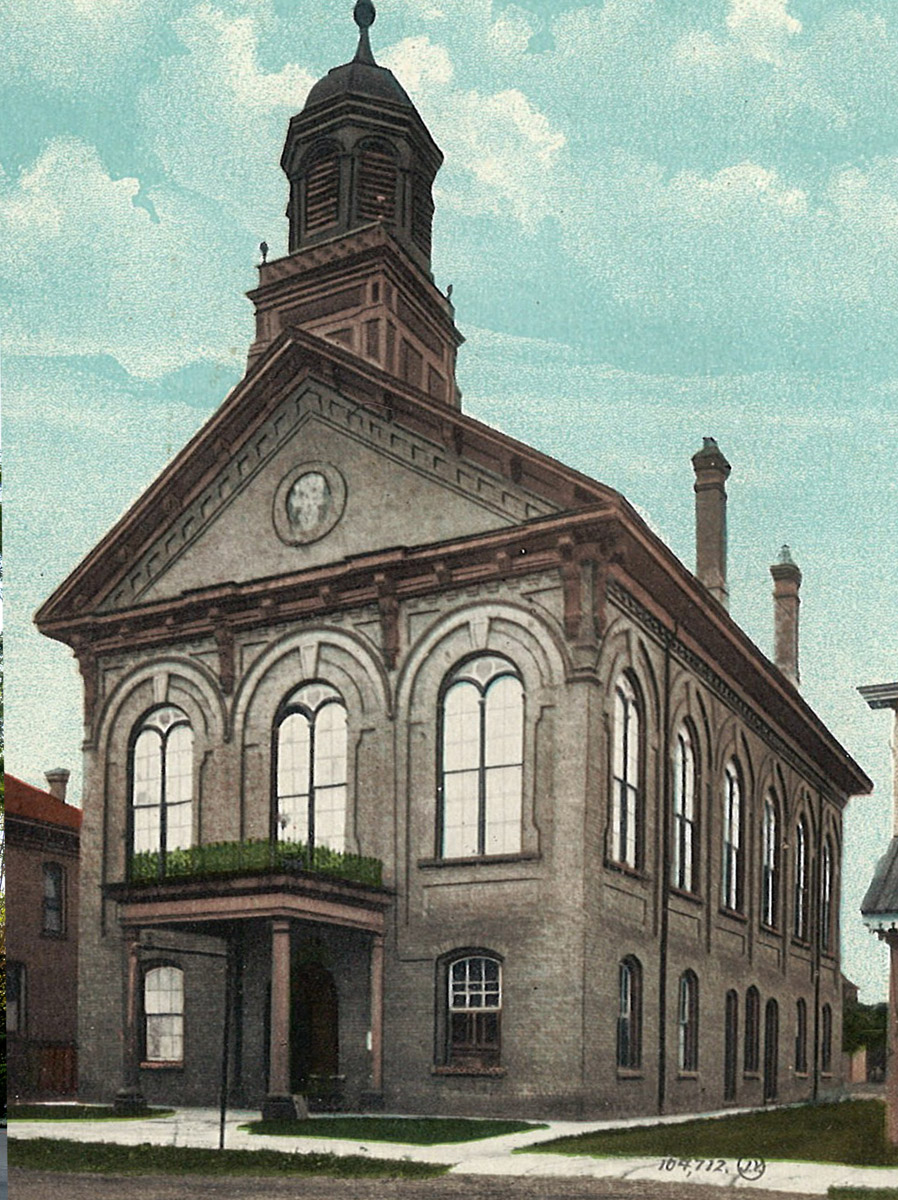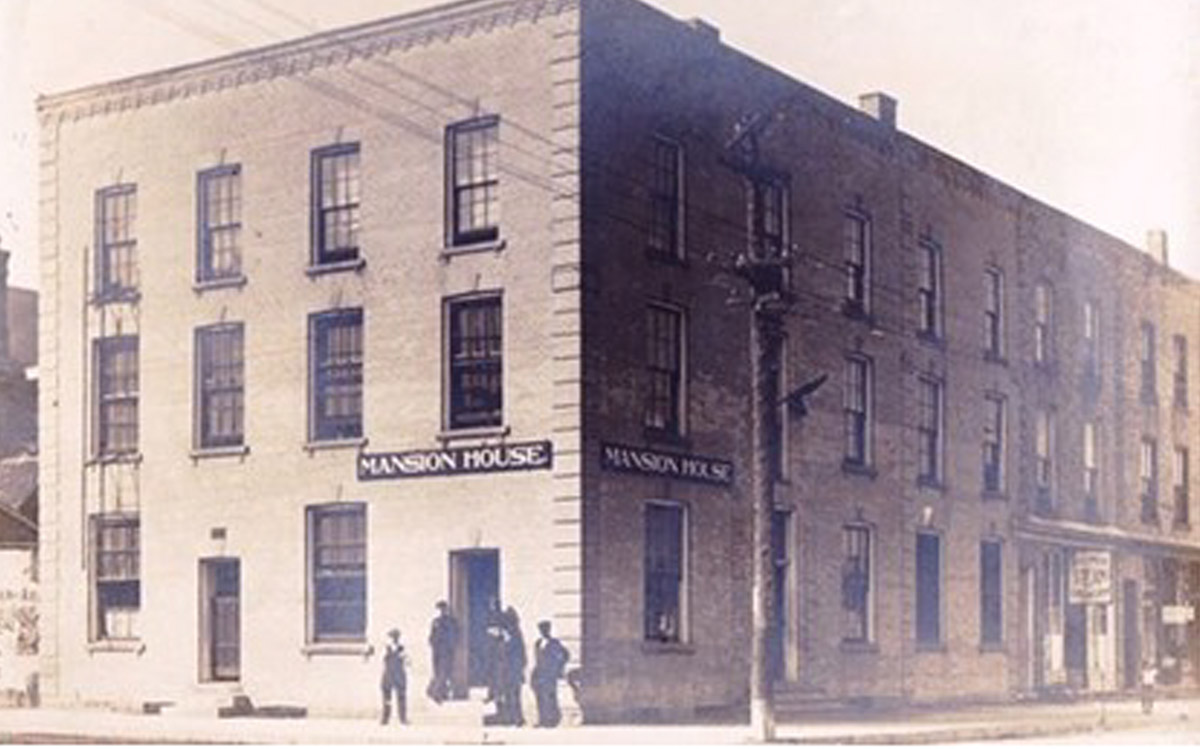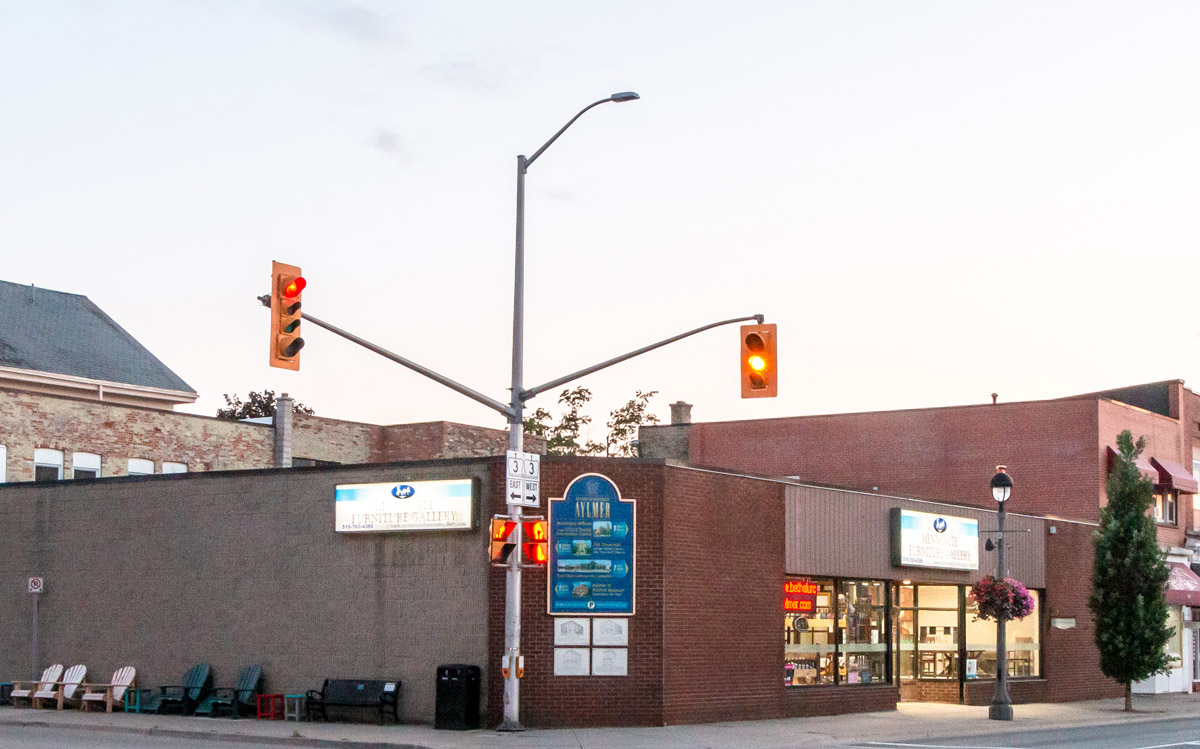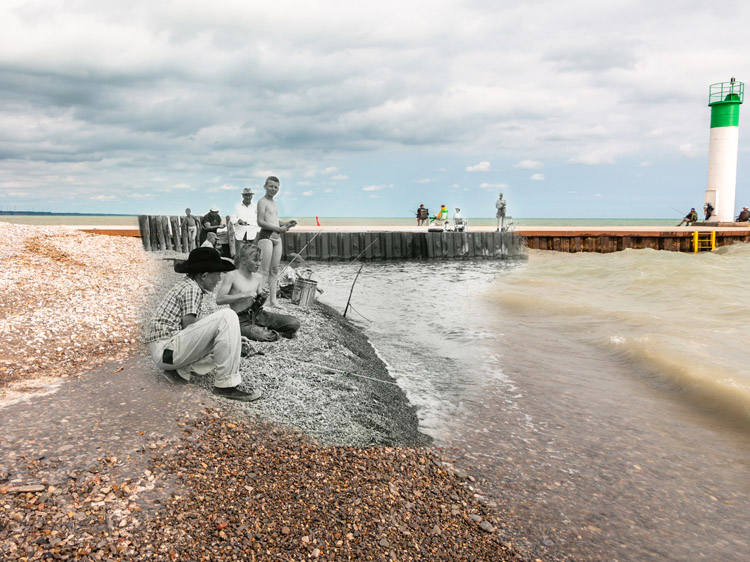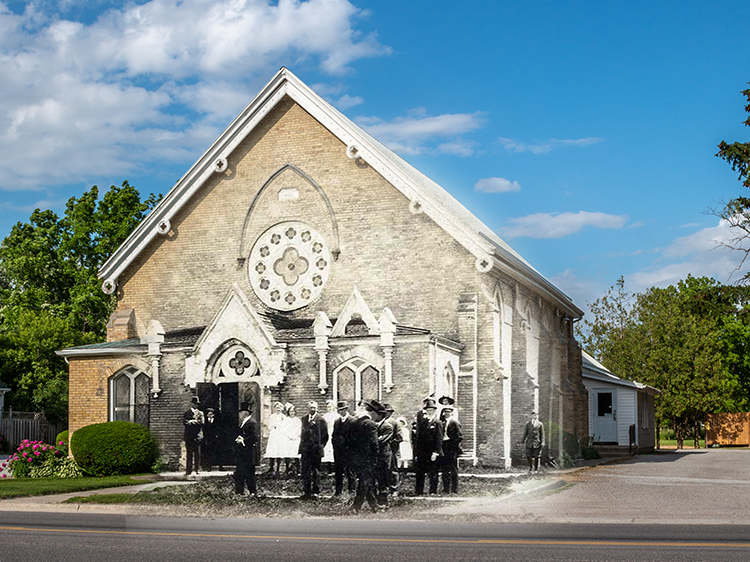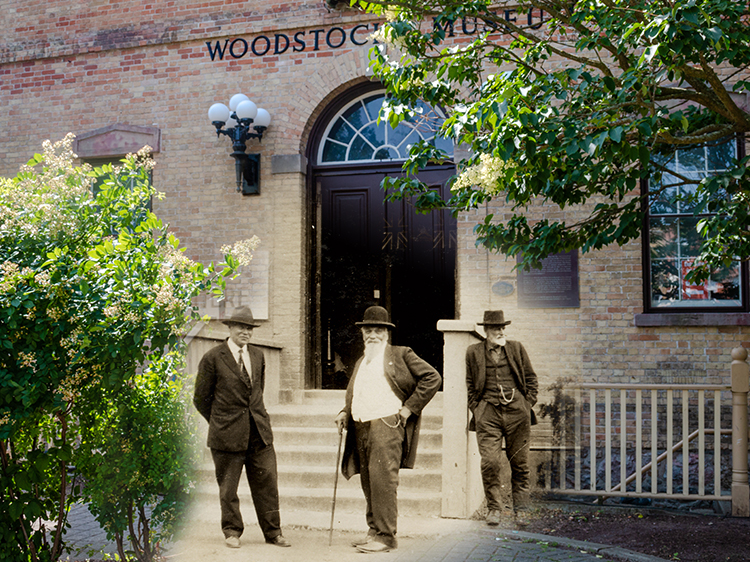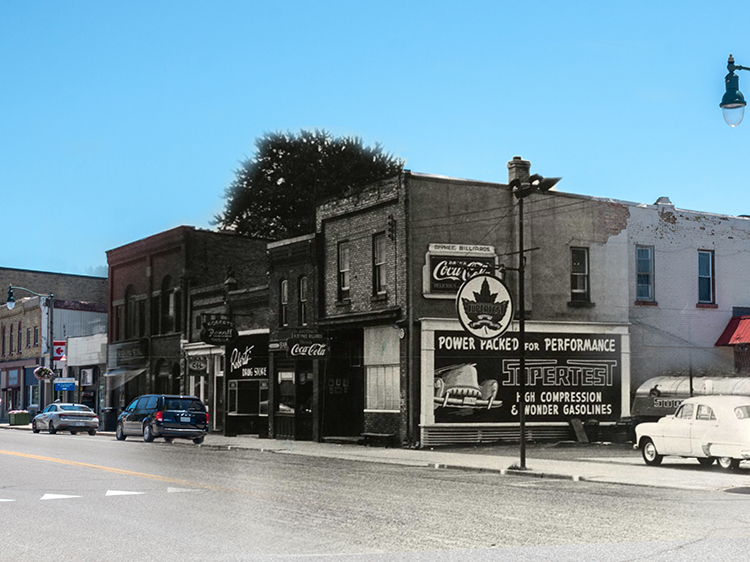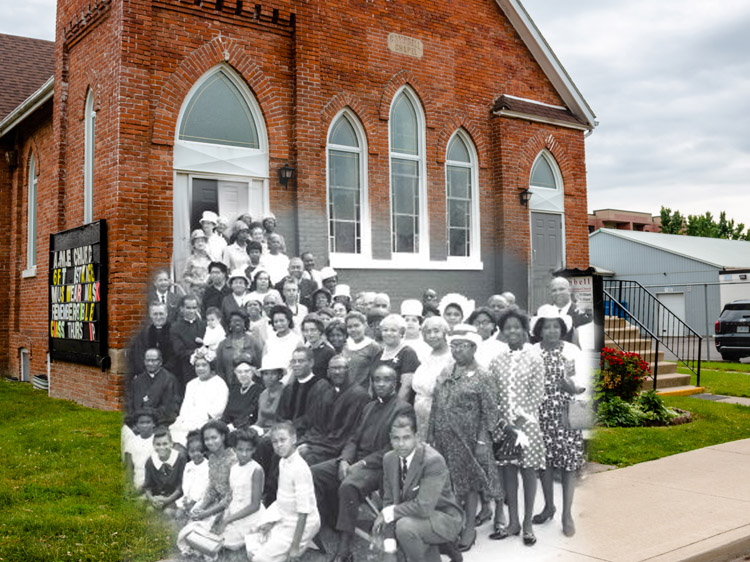Walking Tour
A Jaunt Down Talbot Street
Walking Through Aylmer's History
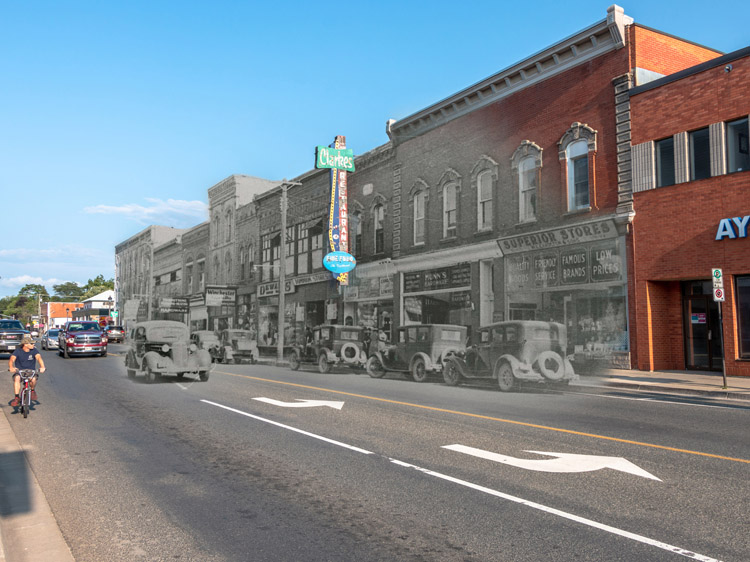
Aylmer-Malahide Museum & Archives
The area where Aylmer is now located has long been the lands of the Attawandaron, Anishinaabe, Mississauga Nation, and Haudenosaunee First Peoples, who have lived here for thousands of years. European settlement in this area began only after the Between the Lakes Treaty No. 3 in 1792. Through the treaty, the Mississauga Nation ceded the land to the British Crown in exchange for a meagre sum.
After this land agreement, many of the first settlers to establish their homes in the area were United Empire Loyalists—American colonists who remained loyal to the British Crown and who had lost their homes in the American Revolutionary War. A village began to develop here in the 1830s, and it was known as Hodgkinson's Corners or Troy for some years before it became Aylmer. As time passed, this settlement grew and thrived, although it faced devastating fires and economic competition with the nearby community of St. Thomas.
This tour explores the history of Aylmer. It is focused on the central intersection of John and Talbot Streets, and tells the stories of the town's historic buildings, early businesses, and notable pioneers.
The tour requires approximately 1.8 kilometres of walking and should take around an hour to complete.
This project is a partnership with the Aylmer-Malahide Museum & Archives.
1. Aylmer's First Inhabitants
Aylmer-Malahide Museum & Archives 1993-012-0004
In this mid-20th century aerial photograph, we can see the growing town of Aylmer. Roads laid out on a grid pattern emanate from the central intersection of John Street and Talbot Street, leading to suburbs and industrial areas. The countryside has been obviously shaped by European settlement, and the lands around the town neatly subdivided into farmer's fields.
This place was of course not always like this. Before European settlement, this region was densely forested by deciduous trees like the eastern hemlock, sugar maple, American beech, and white ash. It was inhabited by Indigenous peoples who are believed to have arrived in this area over 11,000 years ago.
While some European explorers, fur traders, and missionaries passed through this region during the 1600s and 1700s, Europeans didn't begin settling here in earnest until the end of the 1700s. It was then that they began to dramatically reshape the environment, and dispossess the Indigenous people of their land. The first European settlers in what would become known as Aylmer arrived here in the early years of the 1800s and set about clearing land and building homes.
* * *
During excavation of the Pound Site, archaeologists found monumental funerary mounds, and the burned remains of at least one longhouse. Study of this site was instrumental to our understanding of how Indigenous people lived during the Woodland Period. Following the abandonment of the Pound Site, likely after a fire-related event, this land was largely inhabited by the Mississauga Nation.
This region was relatively untouched by colonists until the end of the American Revolutionary War, when the British Crown needed land to settle an influx of Loyalists who had fled the American Republic to lands still under British control. A man named Colonel John Butler was sent to negotiate the purchase of land from the Mississaugas of the Credit.
Butler arranged the Between the Lakes Purchase, which saw the Mississaugas cede some three million acres of land between Lakes Huron, Ontario, and Erie, in exchange for around £1,180 of trade goods, or $319,000 today. This means that the British paid just over the modern equivalent of 10 cents per acre. The purchase was later codified as Treaty 3 in 1792, and reconciled boundary errors in the original purchase.2
Settling in Aylmer
After this treaty English-speaking colonists began to trickle into the region. In 1809, Deacon William Joseph Davis emigrated from the city of Albany, New York, to settle on what is now Talbot St. just east of the modern village of Orwell. Four of his brothers and several other families followed suit.
Noah Davis, Deacon William Davis's cousin, bought the lot at the northeast corner of John St. and Catfish Creek, and the VanPatters owned land on both the northwest and southwest corners. In 1830, John W. Bemer built a general store on the northeast corner of Talbot and John, which was operated by Philip Hodgkinson and a Mr. Keith. A tailor, harness shop, and hotel soon followed, attracting further residents.
At first, the village went by two names: Hodgkinson's Corners (after the general store and post office's owner), and Troy (a classical reference to match the nearby village of Sparta). In 1835 a meeting was called at the local wagon shop to finally settle on an official name. It turned out that 'Troy' had been taken by a city in New York state. Instead, the residents opted for the name Aylmer, in honour of the concurrent Governor General, Lord Matthew Whitworth-Aylmer.3
2. St. Paul's Church
Aylmer-Malahide Museum & Archives
This photo shows Aylmer's Methodist Church, which was built in 1873. The church has a capacity of 700 people and incorporates many impressive architectural features, including a 47-metre steeple which has been lowered several times due to damage from rotting. The addition of 13 stained glass windows in 1923 brought new life to the sanctuary, and in 1956, an educational building was added, housing offices, a kitchen, a stage, and an auditorium. This church was built to replace an earlier building that had been constructed in 1847 on the same spot.
The Methodist congregation in Aylmer was first founded in 1845. Among the community members advocating for the church's foundation were Aaron Price and his wife Esther. The couple moved to Aylmer in 1840 from nearby Norfolk County. Aaron was a confectioner by trade, and was one of seven sons born to Thomas and Frances Price. His parents were United Loyalists who had moved to Canada from New Jersey in 1796. Aaron and his wife came together with other local families to create the first Methodist Church congregation in the area.
* * *
When the American Revolution came to an end in 1783, Loyalist Methodists were pushed north, and many settled in southern Ontario. In 1843, a significant split in the church occurred due to the atrocities of slavery in the United States. Many churchgoers in today's Ontario offered up their homes and church buildings as safe havens on the Underground Railroad to bring enslaved people to safety in Canada. This church split resulted in a Canadian branch of the Methodist Church. Then, in 1925, many of the Methodist Congregations, including Aylmer's, amalgamated with many Presbyterian congregations to create the United Church of Canada.3
3. "The Midnight Fire Alarm"
Aylmer-Malahide Museum & Archives
In this photo, we see the aftermath of one of the many devastating fires in Aylmer's history. On July 18, 1960, we can see that a massive fire has consumed the Bank of Montreal.1
Fire has always been an ever-present threat to Aylmer. As local historian M.L. Aldrich said, "Aylmer has suffered as much if not more than any other town of its size and age, by fires from various cases--incendiarism, spontaneous combustion and accident-- dwelling and business sites have often been left bare and blackened, but the ground has usually been again covered with phoenix-like vigour."2
* * *
A volunteer fire brigade was established in 1872 after a particularly damaging fire—but the fires kept on happening.
In 1874, a series of major fires destroyed much of Aylmer's downtown. One on May 18 started in a vacant store and ultimately destroyed 33 businesses, causing over $60,000 in damage, about $1.5 million today. Just two weeks later another fire started in a cabinet shop and claimed 10 more businesses.
A fire on August 8, 1877 gutted the Commercial Hotel, Murray's Store, a bakery, drugstore, Gent's Furnishings and Farthing's Dry Goods.3 After yet another fire consumed Clutton's Mill in 1880, Mr. Clutton took it upon himself to establish a waterworks system in Aylmer to aid the fire brigade.5
In October of 1884 a poem was published in the Aylmer Express, giving a sense of what it was like for Aylmer's residents to live under this constant threat:
"Tis midnight, and the sleeper,/Lies dreaming, free from care,/But anon his dreams are broken,/By sounds on the midnight air,/Strange sounds like a hissing serpent,/Or the roar of a mighty stream,/Then the fire alarm is sounded,/ And the sleeper awakes from his dream/The fireman, quick to action,/ Like magic springs to his place,/The engines rush by madly,/Like dragons of fire at race./The sound of wheels on the pavement,/ The noise of the swelling crowd,/The shouts of the men at duty,/And the ringing of bells long and loud,/The glaring flames grow hotter,/And wave their wings on high,/The flying sparks grow brighter,/And paint the midnight sky/This demon of fierce destruction,/Known not but a tyrant's harm,/Oh, God protect and save us,/From the midnight fire alarm."6
Even with a waterworks and volunteer fire brigade, fire managed to get the best of Aylmer time and time again. In January of 1890, the Red Star Groceryburned down damaging other shops in the vicinity.
On February 19, 1891, McIntyre & Davis’ store along with Richards’ drug store burned down when a fire started on the upper floor of the nearby dry goods store. It was after this event that the volunteer fire brigade was upgraded to the Aylmer Fire Department with a paid fire chief. On January 28, 1895, the Disciple's Church caught fire, raising suspicion, although foul play was suspected the mystery was never solved.7
In his seminal work on the history of Elgin County, Hugh Joffre Sims wrote, "[Fire] changed the landscape many times, wiping out fortunes and lives."4
Though plagued by fires, the people of Aylmer took what they could save from the rubble and wasted little time in rebuilding. In the 20th century, modern building codes and fire inspections helped mitigate risk, while the fire department acquired modern equipment—the first motorised fire truck joined the department in 1919—allowing for a more effective response. As we can see from the photo at top taken after the fire of 1960, these measures didn't succeed in fully preventing fires. Yet they have gone a long way to mitigating the risk, and today destructive fires in Aylmer are thankfully quite rare.
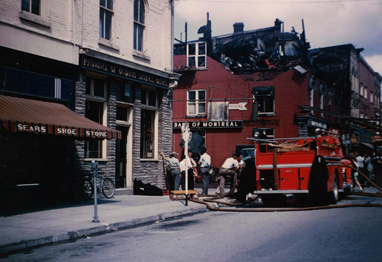
4. Barter and Banking
Aylmer-Malahide Museum & Archives
This shows the Province of Ontario Savings Office (POSO), a government-run bank. The POSO was established in 1922 to help farmers with loans during lean times. This block was destroyed along with most of the rest of this part of downtown in 1965. Afterwards, the POSO was replaced with an RBC which you can see today.1
In towns like Aylmer, local bank branches that could provide access to credit were crucial for the growth of the town. However, dealing with these banks was not without risk.
* * *
During the second half of the 1800s, Aylmer became increasingly urbanized and industrialized, meaning many people were paid wages rather than making their own goods to barter. These workers needed a place to put their money, and places to access credit to buy a house or start a new business. As such a number of small local and regional bank branches opened in Aylmer. Two notable banks to open branches on Talbot Street early on were the Molson's Bank and the Traders Bank.
Financial regulations were extremely lax, and many of these small banks were set up by wealthy local businessmen who were frequently accused of fraud and embezzlement. One of the country's first bankers, Samuel Zimmerman, was a man of his times. While building up the Zimmerman Bank, he used bribery, self-dealing, and nepotism to secure contracts to build railroads across Southern Ontario. He was thought to be one of the wealthiest men in Canada, but at the time of his sudden death in a bridge collapse, both he and his bank were found to be bankrupt .3
Under the circumstances, it is hardly surprising many of these small local banks didn't survive long. They were further buffeted by the frequent recessions, depressions, and financial panics of the era. When they collapsed their depositors were left broke.
In the 1920s the United Farmers of Ontario government moved to protect customers from these risks, and set up the Province of Ontario Savings Office. As a government-owned and guaranteed bank, it provided loans on favourable terms to those with poor credit. It was especially helpful to the many farmers who lived around Aylmer and could be financially ruined by a single bad harvest.
The Aylmer branch of the POSO was destroyed by fire in 1965 and not rebuilt. Instead, it was replaced by an RBC branch you see here, a sign of the changing times. By that time most of the smaller local and regional banks had gone bankrupt or were gobbled up by bigger players with more capital. By the 1990s, banking in Canada was dominated by the so-called Big 5.4 Today four of those banks have branches in Aylmer, including the Bank of Montreal, Royal Bank of Canada, Scotiabank, and CIBC.
As for the POSO, it continued as a government-run bank in other parts of Ontario after the Aylmer branch was destroyed, until it was finally privatized in 2003.
This dramatic news footage of the Great Fire of 1965, showing its tremendous size, and the huge efforts needed to extinguish it. The fire was started when a propane truck stalled at the central intersection of John and Talbot Streets, and then was hit by another truck. Though nobody was killed in the fire, some 33 buildings were destroyed or damaged, with a price tag of over $1 million in damages, or $10 million today. Today many people in Aylmer still remember the fire and the massive impact it had on the community.
5. The Anglican Congregation
Aylmer-Malahide Museum & Archives
This image shows Trinity Anglican Church, which was originally built in 1879 as the Methodist Episcopal Church. The Methodist congregation only used this church for a short while. In 1885 the Anglican congregation, which had grown quite large, purchased this building and rechristened it Trinity Anglican, which it has remained ever since.
This church was the last of several buildings that Aylmer's Anglicans worshipped at. It was later upgraded and improved with the addition of a parish hall in 1954, and a full basement renovation in 1960.1
* * *
St. John's Anglican Church was the Anglican denomination in Aylmer. That original church building was made of pine and sat on a donated parcel of Humphrey Johnson's land, just north of current day College Line in Malahide..
A daughter congregation of the St. John's Anglican Church was the Trinity Anglican, that began in 1850 in Aylmer itself. They built their first church on Water Street on land donated by Nathan Wood and Philip Hodgkinson. Hodgkinson was responsible for starting one of the first businesses in Aylmer, the popular general store and part-time post office. One of Aylmer's original names, Hodgkinson's Corners, came from him and his post office. Though it didn't stay Hodgkinson's Corners for long, Philip remained prominent in the community and became the town clerk.4
The Trinity Anglican congregation quickly grew, and in 1866 the St. John's congregation in nearby Malahide joined Trinity Anglican, and its parishioners worshipped at the Water Street church in Aylmer, while their old church was repurposed as a barn.3 By the 1880s the small Water Street church couldn't hold the rapidly expanding congregation, and it was decided to move to a new building.
As luck would have it the Methodists no longer needed the handsome church building that had been recently built for them. So in 1885 the Anglicans purchased it, renamed it Trinity Anglican, and have worshipped there ever since.
As for the original Trinity Anglican Church on Water Street, it does not survive to the present, though you can still find the church cemetery there in a state of disrepair.
6. A Great Church Merger
Aylmer-Malahide Museum & Archives
The Knox Presbyterian Church was built in 1888 when Aylmer citizen Andrew Murray donated a partial acre of his farmland. The congregation worshipped here for 35 years until the Presbyterian and Methodist churches amalgamated to become the United Church. After that, the Presbyterian congregation moved to St. Paul's United Church and attended joint services with the Methodists there. Knox Church stood empty for eight years before the building and land were sold to the Royal Canadian Legion. Today you can still see the peak of the original church building.1
* * *
"I think that the first sign of a good place to live in is the number of churches and places of worship. When I first wrote about Aylmer in 1939 there were only five churches. In my survey of the same place in 1983, I found that there were eleven places of worship and that all were well-used."2
The concentration of churches in Aylmer certainly conveys the importance of community space and worship in the municipality from its earliest days. The life of a congregation, however, is not a static one. Churches are often changing, splitting, and amalgamating to bring together new and old congregations.
While many of Aylmer's early settlers were Anglican English or Loyalists from America, a smaller group of Scottish also settled in this region and brought with them their Presbyterian faith. Methodism was another branch of Protestant Christianity that took root in England and gradually grew in popularity in Aylmer as well.
The merger of these two churches into the United Church of Canada was a major development in this country's religious history.3
One of the primary motivations behind the merger was the desire of both churches to pool their resources and more effectively proselytize among the Indigenous peoples in the Canadian North and abroad. Though much of this missionary work is now known to have been disastrous for Canada's Indigenous peoples, at the time white Canadians generally accepted and took for granted that the conversion and cultural assimilation of Indigenous peoples was a worthwhile goal.5
Another reason for joining denominations was to create a national church for Canada. Given the Methodist split between the American and Canadian Methodist churches over the issue of slavery and other denominations developing a distinct identity separate from their European or American counterparts, the United church promoted the opportunity for a church that could be "fittingly described as national."6
Aylmer Methodist and Knox Presbyterian joined their congregations in 1923 two years prior to the official joining of denominations indicating that the process of union between denominations in Canada was years in the making prior to official documentation being drawn up and signed. St. Paul's United Church still stands today and brings together citizens of Aylmer for worship and community.
7. The Brown House Hotel
Aylmer-Malahide Museum & Archives
In 1835, Nathan L. Wood built a stopping house in Aylmer called the North American House. The business changed ownership a number of times and was eventually purchased by Hiram Brown, who renamed it the Commercial House. In 1875, the Commercial House was reduced to ash by a fire. Mr. Brown then rebuilt the hotel on the lot and renamed it the Brown House Hotel after himself.1
* * *
"Wood was a remarkable man in many ways. An oft-told story about him is that in 1869 he had a portion of his property converted into a pond for the purpose of raising fish. He started with five large black bass which he obtained from Port Bruce. After stocking his pond he decided to train his fish. Every morning he would summon them by whistling and offering them worms and bits of meat. His fish would obey only his summons, much to the astonishment of people. This little show carried on until the severe winter of 1872 when the pond was frozen solid and his pets perished."3
In 1835, shortly after purchasing the land for the North American House, Nathan Wood left town for a short time to take care of business in Hamilton. At this point, the community now known as Aylmer was known as either Hodgkinson's Corners (named for Philip Hodgkinson) or Troy. While he was on his way to the nearby community of St. Thomas, Mr. Wood learned of a nearby meeting to discuss an official name for the village:
"The name Troy was not regarded with favor by some of the inhabitants, being the name of a town in New York state, and Yankee terms in those days were synonymous of rebellion. Mr. Wood was requested to suggest a name, and he proposed Aylmer, (probably receiving the inspiration from the fact that Lord Aylmer was then Governor General of Canada.) The name was put to vote and carried with but few dissenting voices, and Aylmer was the recognized name afterwards, though the village was called Troy the more frequently until the establishment of the postoffice in 1837."4
The rebuilt Brown House Hotel later changed its name to the Aylmer Inn. On April 16, 1934, however, fire once more struck the building, reducing it to ruin and killing Mrs. Wetherall and her two children.5 In the aftermath of this disaster, the block was rebuilt as a retail space and was eventually demolished in the 1970s.6
8. Postmaster Hodgkinson
Aylmer-Malahide Museum & Archives
Built in 1913, this Romanesque-style building was Aylmer's post office and customs house until 1974, when it became the Town Hall and the post office was moved to another location.1 The elegant four-storey structure is one of the most prominent buildings on Aylmer's skyline, hinting at the importance given to the postal service in the town's development.
* * *
As M.L. Aldrich wrote in 1888:
"About the year 1820 the settlement in and around Aylmer began to assume an aspect of progress, though Orwell, then called Temperanceville, had the lead... A post office was opened in Orwell, about this time, R. L. McKinney being appointed postmaster which position he held until a short time before the rebellion [of 1837], when the agitation prostrated his nerves and he went over to visit Brother Jonathan, but afterwards returned to Orwell and died there. The late Philip Hodgkinson was then commissioned by Government to remove the office to Aylmer."2
Hodgkinson was postmaster from 1836 until his resignation in 1875 due to ill health. He ran the post office out of his general store, and as a result the tiny settlement was initially named Hodgkinson's Corners. Throughout his time as postmaster Mr. Hodgkinson witnessed and implemented many changes as the Canadian postal service worked to define itself and its responsibilities:
In 1847 it was suggested that the provincial authorities should take charge of their own postal systems as well as implement a standard rate for delivery. In 1851 Canada came out with its first postage stamp. The three-pence beaver was to be affixed to every letter sent out for mail to show that a standard rate had been paid.3
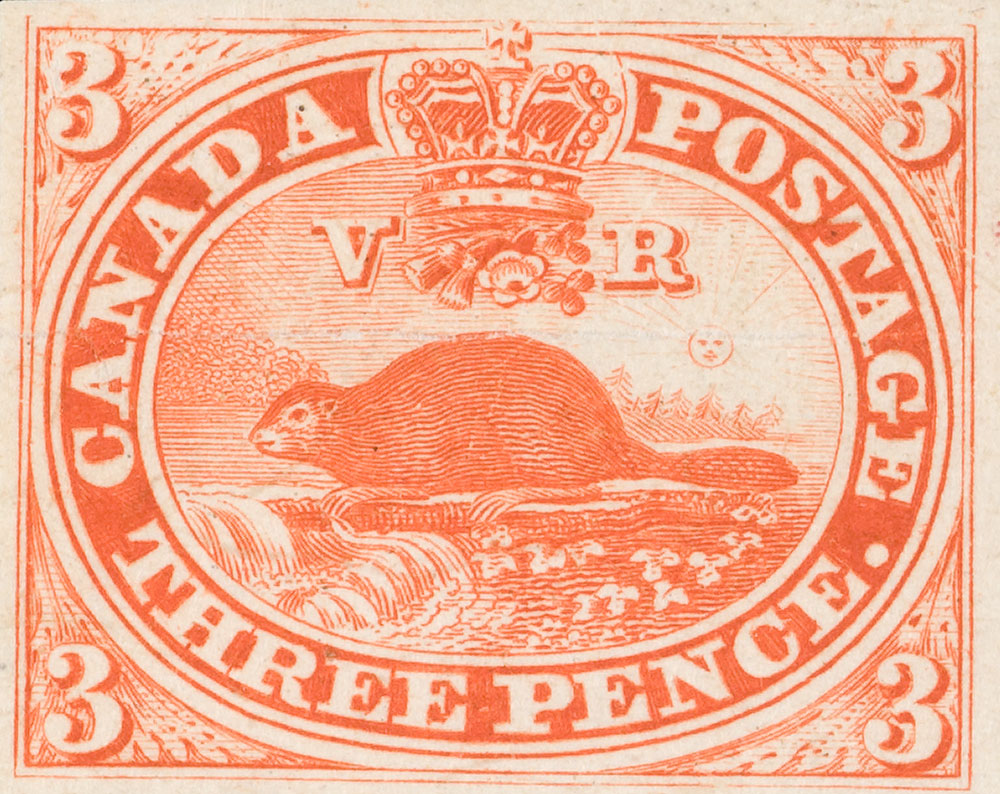
As Canada came closer to Confederation and began carving out a national identity, the postal service was making changes to keep up with the demand. In 1855 a registered mail system and money order policy was introduced to make shipping money and confidential mail more secure. In 1868, just one year after Confederation, a standard uniform was issued for dominion post offices creating a unified visual appearance for all of Canada's postal workers. In 1871 pre-stamped blank postcards were introduced and just three years later 'return to sender' mail was implemented. Finally in 1875 government departments were granted free mailing privileges.4
Mr. Hodgkinson's tenure as postmaster lasted until 1875, meaning he witnessed all these changes and more in his time serving Aylmer.

9. The Sheppard Restaurants
Aylmer-Malahide Museum & Archives
The Chuck Wagon restaurant, owned by Raymond Sheppard, was known for its burgers and fries in the late 1950s and 1960s. The restaurant opened for business in 1958 across the street from another of Mr. Sheppard's businesses, the popular 'Sheppard's Coffee Shop.
* * *
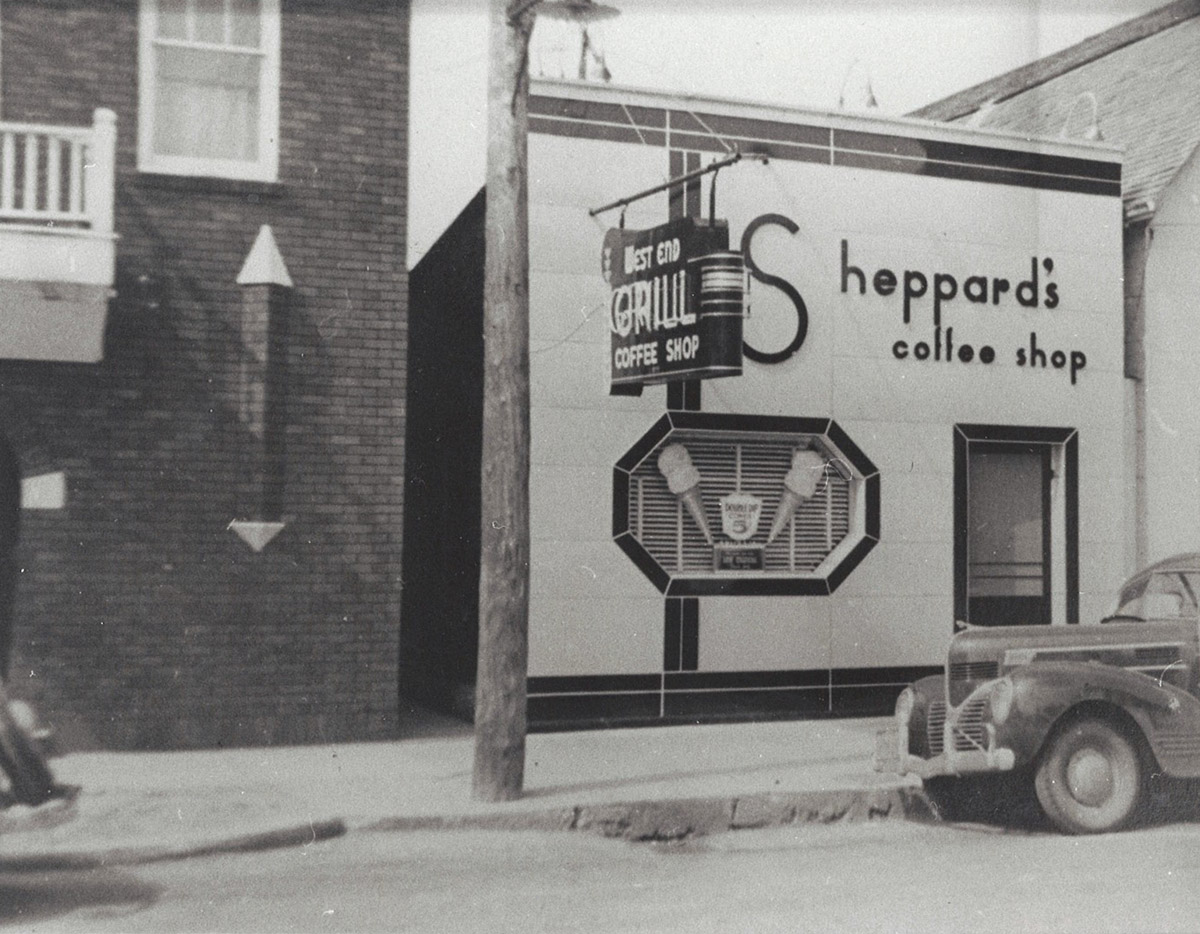
Mr. Sheppard and Mr. Christie worked out a deal that Sheppard would be the financier and Christie would manage day-to-day operations. At its peak, Sheppard's Coffee Shop had fifteen employees, many of whom were the wives of RCAF trainees and instructors. One of the first hires to assist at the shop was Mrs. Beatrice Snyder Betterley:
"The first day clerk that he hired was Mrs. Beatrice Snyder Betterley (…) she was known to work all day, go home at 7 pm and return at 8:30 pm. She told Ray Sheppard that there was not anything going on anywhere else in town, so she 'might as well be where the action was.'"
Originally offering 24-hour service to accommodate the schedules of patrons working night shifts, Sheppard's scaled back its hours when the Second World War broke out, closing at 2:00 am. Further reductions to hours were made in the coming years, eventually closing up at 11:00 pm.
By the 1950s the Sheppards detected a change in dining habits. As Mary Sheppard said at the time: "The new type of restaurant, ordering at the counter and carrying your own tray of food to your booth appeals to a great number of people and of course the young people enjoy it."
When they opened the Chuck Wagon you see here, it was immensely popular with high school students. They didn't stay in the business for long however, and within a year the Sheppards sold both the Chuck Wagon and the coffee shop.
After consulting for the restaurant industry for a number of years Mr. Sheppard bought back his coffee shop in 1961 and ran it until 1965 when it was permanently closed due to the lack of tourists in Aylmer.1
He sold the Chuck Wagon which continued operating under new management for many years until it ultimately closed as well. The restaurant building was torn down following a fire in 1994.
10. Aylmer and the World Wars
Aylmer-Malahide Museum & Archives
The Aylmer Cenotaph was dedicated on November 25, 1928 by Captain E.W. Hair to remember those from Aylmer and Malahide who fell in the First World War. Mrs. Ida Haight was given the honour of unveiling the monument—she had lost two sons.
The cenotaph itself is made from two granite pieces from the Cleveland Stone Company and designed by John Hutchinson and William Peckham of J.W. Hutchinson’s Marble Works. The original inscription listed the fifty-five men who died during the First World War. It was later inscribed to commemorate Aylmer's fallen in the Second World War and the Korean War.1

John Hutchinson, designer of Aylmer's cenotaph, and later mayor of Aylmer.
* * *
"Lieutenant Clarke had no difficulty in recruiting the quota of twenty assigned Aylmer for the battery of Field Artillery now being mobilized at London. As a matter of fact, several over the number required made application…Between 600 and 700 citizens were present when the boys lined up on Talbot street yesterday morning, and rousing cheers were given them, as, headed by the Citizens Band, and followed by the members of the 30th Battery and citizens they marched to the Wabash depot to entrain for London.
"...The occasion proved a very impressive one, the more so when one loving mother was overcome, in the fear that she might never see her boy again. There were few dry eyes, even one of the speakers finding it impossible to express himself for some moments.
"The boys, however, with brave hearts, broke into song, which relieved the tension, were photographed, the hat was passed for their benefit, and they boarded the train amid the cheers and best wishes of some 500 citizens."2
Yet the 55 men from Aylmer who ultimately fell in battle was a fearsome cost for such a small community to pay.

During the Second World War, Aylmer was home to a Royal Canadian Air Force (RCAF) pilot training station. The compound consisted of fifty buildings, five hangars and three runways. The school was the first to use radios as a part of their program and began a women's division a year after the school opened in 1941.3
"Since our last edition went to press, our Station has been considerably brightened by the arrival of a number of the Women's Division of the Royal Canadian Air Force. Women in the armed forces in Canada is a new departure from old traditions, which stated that 'men must fight and women stay home and weep."4
The base also helped stimulate Aylmer's economy, countering the lingering effects of the Great Depression. There were jobs for those building and staffing the base, while restaurants and coffee shops served the many trainees and instructors.
By the war's end in 1945, the RCAF school had graduated 4,144 pilots. The school was closed in September of 1961 when the building was transferred to the provincial government. Afterwards, the hangars were used for storage by the Cured Tobacco Board and the Canadian Canners Co-Operative. The main campus became the Ontario Police College after 1961, a role it continues to fulfill to this day.5
11. The Baptist Church
Aylmer-Malahide Museum & Archives
In 1843, the Baptist congregation in Aylmer erected a wood-frame building to house church services and programming. Nearly three decades later, in 1871, the congregation replaced this simple structure with a permanent brick church. On July 12, 1950, a fire destroyed all but the outer shell of this building. Only the walls and tower remained. The Baptist congregation held services in the Royal Canadian Legion Hall and St. Paul's United Church until their new building was finished in 1951. A chapel was added later in 1963.1
* * *
*"[Reverend Joseph Clutton] was born in England, in the year 1802, and came to Canada in 1832, settling in West Flamborough. For some years previously he had followed farming, but later adopted teaching as a profession. Upon locating in West Flamborough he again engaged, for a period, in teaching, being a man of culture and wide learning. He was also a man of strong religious fervour, and about two years after his arrival in Flamborough he entered the ministry of the Baptist church."3
Reverend Joseph Clutton led the Aylmer Baptist Church until his death in 1882. He was a character of many talents and also owned a sawmill near Rogers Corners, which he had purchased upon his arrival in Elgin County. Rev. Clutton and his son Joseph jointly ran the mill for many years.4
"In 1876 [Reverend Clutton] with his aged wife, celebrated their golden wedding. The celebration took place in the Baptist church, Aylmer, where a large number of relatives and friends congregated, and Mr. Clutton was presented with a handsome gold medal to commemorate the affair, besides numerous other gifts. Mrs. Clutton died in the fall of 1885, at the ripe age of 88 years."5
Reverend Clutton passed away in 1882 at the age of eighty after having been the pastor of Aylmer's Baptist Church for some thirty years.
12. The Catholic Church
Aylmer-Malahide Museum & Archives
In 1939, the Catholic church congregation purchased a parcel of land on which to build a new church. The cornerstone of the new building was laid on December 10 of that year. The first mass was held in the half-completed building's basement on January 14, 1940. After this quick beginning, momentum slowed, and the upper storey was not completed until 1951. As you can see, the image above was taken in that interlude before the second storey was added. The local Catholic congregation still uses this building today.1
* * *
That year, the congregation decided to rent the space above what would later become the Foodland Grocery Store, and the parish was officially named the St. John's Catholic Church. Then, in 1913, a house was purchased on St. George Street and mass was held there until 1937. Afterwards, the congregation rented the hall over the hardware store for a short time. Finally, in 1939, the church found its permanent home, where it still stands today.3
"The new church is built from a design that is purely colonial in architecture. It has a length of 130 feet from the four Greek Doric columns in front to the wall back of the main altar. With its width of 40 feet the new edifice will have seating for 450. The church rises from the ground level some 44 feet to the peak of the copper roof, on top of which there is a 38 foot steeple surmounted by a six foot cross."
- St. Thomas Times Journal, 19424
The church stands as an impressive symbol of the Catholic community. It was designed by Mr. J. Green, an architect from St. Thomas, but in many ways, its creation was a community effort.
"The bell in the tower was the gift of four Hungarian families of the parish: Mr. and Mrs. Joseph Fath, Mr. and Mrs. Gaza Gruber and Mr. and Mrs. Lawrence Kalman…and when installed will have a G flat note which will be heard throughout the entire community."5
"All in all, both inside and out, the new church is a beautiful monument to Our Blessed Mother, and a fitting dwelling place for our Sacramental Lord. Too, it is a testimony to the faith of the parishioners of Our Lady of Sorrows Parish, who have made such sacrifices for the completion of this new House of God."
- Father White quoted in St. Thomas Times Journal, 19426
13. Community Space
Aylmer-Malahide Museum & Archives
Although this church's completion came quite late in Aylmer's history, the community's Catholic congregation first met nearly half a century earlier. In 1901, a visiting priest from St. Thomas held the first mass in the home of John Kiley. For the next decade, the congregation gathered in homes around Aylmer, but by 1911, a larger and more permanent space was necessary.2
That year, the congregation decided to rent the space above what would later become the Foodland Grocery Store, and the parish was officially named the St. John's Catholic Church. Then, in 1913, a house was purchased on St. George Street and mass was held there until 1937. Afterwards, the congregation rented the hall over the hardware store for a short time. Finally, in 1939, the church found its permanent home, where it still stands today.3
The new church is built from a design that is purely colonial in architecture. It has a length of 130 feet from the four Greek Doric columns in front to the wall back of the main altar. With its width of 40 feet the new edifice will have seating for 450. The church rises from the ground level some 44 feet to the peak of the copper roof, on top of which there is a 38 foot steeple surmounted by a six foot cross.(St. Thomas Times Journal, 1942)4
The church stands as an impressive symbol of the Catholic community. It was designed by Mr. J. Green, an architect from St. Thomas, but in many ways, its creation was a community effort.
The bell in the tower was the gift of four Hungarian families of the parish: Mr. and Mrs. Joseph Fath, Mr. and Mrs. Gaza Gruber and Mr. and Mrs. Lawrence Kalman…and when installed will have a G flat note which will be heard throughout the entire community. (St. Thomas Times Journal, 1942)5
All in all, both inside and out, the new church is a beautiful monument to Our Blessed Mother, and a fitting dwelling place for our Sacramental Lord. Too, it is a testimony to the faith of the parishioners of Our Lady of Sorrows Parish, who have made such sacrifices for the completion of this new House of God,(Father White quoted in St. Thomas Times Journal, 1942)6
* * *
"The [first] Town Hall was built by the Township of Malahide in 1850, on the site of Henery Arkell's house, and a short distance in the rear was the Drill Shed. The former was sold to Abram Beemer, when the new Town Hall was built, in 1873, and he took it down and sold the lumber and timber to other parties, so it is hard to say what has become of it, though it is said that there is one relic of it remaining somewhere."2
The new Town Hall was thought to be an elegant structure and boasted functional spaces for council, a library and reading room for the Mechanics Institute, and a concert hall. It was highly admired for its beauty by the community of Aylmer and became a multi-purpose space for community use.3
The Opera House was located on the second floor of Town Hall and hosted church services, large meetings, and minstrel shows throughout the late 1800s and into the mid-1900s. A diverse selection of performers played here, including the famous Rosa D'Erina, an Irish soprano, organist and pianist. By 1896, however, the Opera House was thought by many in the town to be too small for some of the shows that the community was eager to host, and the building underwent repairs to ensure that it could accommodate and attract these shows. Some of the most popular performances in the 1940s were put on by the Aylmer Boys' Band, who performed to sold-out crowds time and time again.4
Another popular performer was the poet Tekahionwake (who was often known by her English name Emily Pauline Johnson). Tekahionwake performed in the traditional dress of her nation (part of the Six Nations Confederacy) and was among the most famous people to perform at Town Hall. She wrote prolifically about prominent Indigenous figures and stories:
The path of coals outstretches, white with heat, A forest fir's length - ready for his feet. Unflinching as a rock he steps along The burning mass, and sings his wild war song; Sings, as he sang when once he used to roam Throughout the forests of his southern home, Where, down the Genesee, the water roars, Where gentle Mohawk purls between its shores, Songs, that of exploit and of prowess tell; Songs of the Iroquois invincible.
-Excerpt from "As Red Men Die" by Emily Pauline Johnson5
The new Town Hall building (which is now called the Old Town Hall) still stands today as a symbol of community activism and preservation efforts. It continues to serve Aylmer as a theatre and library, retaining much of its original purpose.
14. Mr. and Mrs. Mott
Aylmer-Malahide Museum & Archives
The Mansion House Hotel was a prominent hotel in Aylmer in the late 19th and early 20th centuries, competing with the Brown House and the Kennedy Hotel. Before it stood here, the site was occupied by other establishments, including the National Hall, which later changed its name to the National Hotel. When the National Hotel burned down in 1872 it was replaced by the Mansion House.1 Subsequently the building was a Merchants Bank of Canada and a grocery store. It was destroyed in the great fire of 1965.
Eventually, a new building was erected on this corner, and today it houses the Mennonite Furniture Gallery.
* * *
Many interesting stories are told of the Mott family. While Roswell Mott was running the National Hotel, Mrs. Mott had a pet parrot who could speak:
"They had just sat down to dinner, when the parrot, which was in a cage outside the door, commenced to screech "fire, fire! Take care, take care!" where upon Mrs. Mott ran to the door thinking some dog was attempting to get her pet, when she discovered the air full of smoke, and thus they learned of the fire."3
Mr. Roswell Mott himself was much more than a hotel proprietor, playing a role in the 1837 Upper Canada Rebellion:
"One day a squad of British troops were passing through the place, when Mr. Mott took his violin and played Yankee Doodle. The company halted and listened. And then took Mott prisoner. That tune in those days savoured too much of rebellion and could not be tolerated. Mr. Mott, however, escaped being sent to Toronto, by enlisting. Having had experience in military tactics he soon gained favor and was commissioned a Captain of the Commissary, to go to Fort Malden. They went as far as St. Thomas but there got orders to return, and Mr. Mott was then directed to scour the country in search of arms. With a dozen men he went all over the neighbourhood and seized every old rusty shot gun and pistol to be found, After the trouble had been quelled and quiet again restored Mr. Mott returned to his business."4
15. Kennedy Central Hotel
Aylmer-Malahide Museum & Archives
Thomas Kennedy purchased the property for the Kennedy Central Hotel from William Farthings on May 28, 1883. The style of the hotel was similar to its contemporaries on Talbot Street, and it was built in a Romanesque style with delicate brickwork. The structure is said to have an exterior three bricks thick.1
* * *
"Aylmer possesses 6 hotels, 4 of which are second to none in any town of Aylmer's size in Ontario, namely, the Brown House, H.J. Brown proprietor; Kennedy Central, T.T. Kennedy, proprietor; Mansion House, S. Wismer, proprietor; Mero House, John Mero, proprietor; besides there is the Air Line Hotel (…) the Park House (…) and Electric Hall, temperance house (…) The Scott Act came in force in the County 1st May, 1886, which prohibits the sale of all intoxicating liquors."2
Prior to Thomas Kennedy's purchase of this property, the land was home to Martin's Hotel, which was built in 1844. In the 1860s, its name was changed to Laing's Hotel. Tragically, this building burned down in 1862 only a short time after it had opened under its new name. Laing's Hotel was immediately rebuilt after the fire and was purchased by Adolphus Williams and Peregrine Mann in 1872. It was then renamed the British American Hotel.3
"The Central Hotel was and is an imposing structure, solid and of some mass, the cornerstone on the eastern end of a block of 2 and 3 storey brick buildings. It is a lofty 3 storeys and is crowned by an ornate brick cornice. Tall windows, placed one above the other three floors up, all with Romanesque top sashes and raised architraves add to its height and presence."4
The Kennedy Block still stands today as a designated heritage resource:
"The brick walls, to stonework and the windows on both the north and east facades should be designated, reminders of the many innkeepers and numerous travelers, the rooms, meals, and personal services available in Aylmer in the 1880s."5
The Kennedy Block allows us to look back at Aylmer in its earlier days. Talbot Street itself offers something similar. While walking among the early buildings of Aylmer, one can hear the church bells, see the structures, and imagine what it might have been like to be an early citizen of this lovely town.
Endnotes
1. Aylmer's First Inhabitants
1. Robert James Pearce, "Mapping Middleport: A Case Study in Societal Archaeology", Graduate Thesis, (McGill University, 1984), 35.
2. Deborah Welch and Michael Payne, "Aylmer (Ont)," The Canadian Encyclopedia, online.
3. "Aylmer: History of a Town," Elgin County, online.
2. St. Paul's Church
1. "Churches" Aylmer: The History of a Town, online.
2. The Wesleyan Church of Canada, "History of the Wesleyan Church in Canada," online.
3. "History of the Wesleyan Church in Canada", online.
3. "The Midnight Fire Alarm"
1. "Aylmer Fire of 1965 Focus of Exhibit Fifty Years Later," Relish Elgin, online. http://www.relishelgin.ca/heritage/aylmer-fire-of-1965-focus-of-exhibit-fifty-years-later
2. M.L. Aldrich, Aldrich's Pocket Directory of the Town of Aylmer. 1888. Image 47.
3. Sims, Hugh Joffre, Sims' History of Elgin County. Elgin County Library, 1984. 16-19.
4. Sims, Hugh Joffre, Sims' History of Elgin County. Elgin County Library, 1984. 16.
5. Sims, Hugh Joffre, Sims' History of Elgin County. Elgin County Library, 1984. 16.
6. "The Midnight Fire Alarm," Aylmer Express and East Elgin Advertiser, online.
7. Sims, Hugh Joffre, Sims' History of Elgin County. Elgin County Library, 1984. 16-19.
4. Barter and Banking
1. Sims, Hugh Joffre, Sims' History of Elgin County. Elgin County Library, 1984.18-19.
2. M.L. Aldrich, Aldrich's Pocket Directory of the Town of Aylmer. 1888. Image 39-40.
3. Johnson, J. K.. "Samuel Zimmerman." The Canadian Encyclopedia. Historica Canada. Article published June 04, 2008; Last Edited December 16, 2013.
4. Granger, Alix. "Banking in Canada." The Canadian Encyclopedia. Historica Canada. Article published February 01, 2012; Last Edited August 01, 2017.
5. The Anglican Congregation
1. "Churches" Aylmer: The History of a Town. Accessed January 31, 2022. https://www.elgincounty.ca/ElginCounty/CulturalServices/Archives/aylmer/churches.
2. "A Brief History," The Anglican Church of Canada. Accessed February 2, 2022. https://www.anglican.ca/about/history/
3. Sims, Hugh Joffre, Sims' History of Elgin County. Elgin County Library, 1984. 22-23.
4. Ibid.
5. M.L. Aldrich, Aldrich's Pocket Directory of the Town of Aylmer. 1888. Image 39-40.
6. A Great Church Merger
1. "Churches" Aylmer: The History of a Town. Accessed January 31, 2022. https://www.elgincounty.ca/ElginCounty/CulturalServices/Archives/aylmer/churches
2. Sims, Hugh Joffre, Sims' History of Elgin County. Elgin County Library, 1984. 22.
3. "History of The United Church of Canada," The United Church of Canada. Accessed February 4, 2022. https://united-church.ca/
4. "Basis of Union" The United Church of Canada. 1925. 2. https://united-church.ca/sites/default/files/basis-of-union.pdf
5. "History of The United Church of Canada," The United Church of Canada. Accessed February 4, 2022. https://united-church.ca/
6. "Basis of Union" The United Church of Canada. 1925. 2. https://united-church.ca/sites/default/files/basis-of-union.pdf
7. The Brown House Hotel
1. Sims, Hugh Joffre, Sims' History of Elgin County. Elgin County Library, 1984.14.
2."Aylmer Register of Properties of Cultural Heritage Value or Interest" Aylmer.ca, online.
3. Sims, Hugh Joffre, Sims' History of Elgin County. Elgin County Library, 1984. 14.
4. M.L. Aldrich, Aldrich's Pocket Directory of the Town of Aylmer. 1888. Image 37.
5. Sims, Hugh Joffre, Sims' History of Elgin County. Elgin County Library, 1984. 17.
6. "Aylmer Register of Properties of Cultural Heritage Value or Interest" Aylmer.ca, online.
8. Postmaster Hodgkinson
1. "Government Services," Elgin County, online.
2. M.L. Aldrich, Aldrich's Pocket Directory of the Town of Aylmer. 1888. Image 33.
3. "A Chronology of Canadian Postal History," Canadian Museum of History, online.
4. "A Chronology of Canadian Postal History," Canadian Museum of History, online.
9. The Sheppard Restaurants
1. "Photograph Description" Item 2006-013-0009. Aylmer-Malahide Museum & Archives.
10. Aylmer and the World Wars
1. "Cenotaph," Aylmer.ca. Accessed February 1, 2022, online.
2. "Off For the Front," The Aylmer Express, November 19, 1914.
3. "No.14 Service Flying Training School, Aylmer" Elgin County, online.
4. The Aylmer Airman: Volume 1, No. 8. March 13, 1942 (Page 1)
5. "RCAF Station Aylmer" RCAF.info, online.
11. The Baptist Church
1. "Churches" Aylmer: The History of a Town, online.
2. "Churches" Aylmer: The History of a Town, online.
3. M.L. Aldrich, Aldrich's Pocket Directory of the Town of Aylmer. 1888. 46.
4. M.L. Aldrich, Aldrich's Pocket Directory of the Town of Aylmer. 1888. 46.
5. M.L. Aldrich, Aldrich's Pocket Directory of the Town of Aylmer. 1888. 46.
12. The Catholic Church
1. "Churches" Aylmer: The History of a Town, online.
2."Churches" Aylmer: The History of a Town, online.
3."Churches" Aylmer: The History of a Town, online.
4. Sims, Hugh Joffre, Sims' History of Elgin County. Elgin County Library, 1984.
5. Sims, Hugh Joffre, Sims' History of Elgin County. Elgin County Library, 1984.
6. Sims, Hugh Joffre, Sims' History of Elgin County. Elgin County Library, 1984.
13. Community Space
1. "Old Town Hall 38 John St S," Aylmer.ca, online.
2. M.L. Aldrich, Aldrich's Pocket Directory of the Town of Aylmer. 1888. Image 52.
3. "Building Heritage," ElginCounty.ca. November 12, 2011, online.
4. "Building Heritage," ElginCounty.ca. November 12, 2011, online.
5. Emily Pauline Johnson "As Red Men Die" online.
14. Mr. and Mrs. Mott
1. Sims, Hugh Joffre, Sims' History of Elgin County. Elgin County Library, 1984. (15-16)
2. Sims, Hugh Joffre, Sims' History of Elgin County, 1984. (15-16)
3. M.L. Aldrich, Aldrich's Pocket Directory of the Town of Aylmer. 1888. Image 51-52.
4. M.L. Aldrich, Aldrich's Pocket Directory of the Town of Aylmer. 1888. Image 43.
15. Kennedy Central Hotel
1. "Heritage Designation, 62 Talbot St. East Aylmer, ON" Town of Aylmer, online.
2. M.L. Aldrich, Aldrich's Pocket Directory of the Town of Aylmer. 1888. Image 66.
3. "Heritage Designation, 62 Talbot St. East Aylmer, ON" Town of Aylmer, online.
4. "Heritage Designation, 62 Talbot St. East Aylmer, ON" Town of Aylmer, online.
5. "Heritage Designation, 62 Talbot St. East Aylmer, ON" Town of Aylmer, online.
Bibliography
Abler, Thomas S., "Oneida," The Canadian Encyclopedia, Historica Canada, June 06, 2011, last edited June 1, 2020, online.
Anglican Church of Canada, "A Brief History," The Anglican Church of Canada. Accessed February 2, 2022. https://www.anglican.ca/about/history/
Aldrich, M.L., Aldrich's Pocket Directory of the Town of Aylmer. 1888. https://www.canadiana.ca/view/oocihm.8_00067_1/20?r=0&s=1
Aylmer,"Cenotaph," Aylmer.ca. Accessed February 1, 2022. https://aylmer.ca/living-in-aylmer/attractions-in-aylmer/cenotaph/
Aylmer, "Old Town Hall 38 John St S," Aylmer.ca. Accessed February 1, 2022. https://aylmer.ca/living-in-aylmer/history/old-town-hall-38-john-st-s/
Aylmer, "Aylmer Register of Properties of Cultural Heritage Value or Interest" Aylmer.ca. Accessed February 1, 2022.
The Aylmer Airman: Volume 1, No. 8. March 13, 1942 (Page 1)
Aylmer Express, "The Midnight Fire Alarm," Aylmer Express and East Elgin Advertiser. Aylmer, Ontario. October 3, 1884. https://inmagic.elgin.ca/en/permalink/archives181607
Aylmer Express, "Off For the Front," The Aylmer Express, November 19, 1914.
Canadian Museum of History, "A Chronology of Canadian Postal History," Canadian Museum of History. Accessed February 3, 2022. https://www.historymuseum.ca/cmc/exhibitions/cpm/chrono/chs1841e.html
The Children Remembered, "Mount Elgin Industrial School," The Children Remembered. Accessed February 2, 2022. https://thechildrenremembered.ca/school-histories/mount-elgin/
Elgin County, "Churches" Aylmer: The History of a Town. Accessed January 31, 2022. https://www.elgincounty.ca/ElginCounty/CulturalServices/Archives/aylmer/churches
Elgin County, "Photograph Description" Item 1991-007-0023. Elgin County Archives. https://heritagecollections.elgin.ca/en/list?q=ontario+savings+office&p=1&ps=20
Elgin County, "Photograph Description" Item 2006-013-0009. Elgin County Archives. Accessed February 5, 2022. https://heritagecollections.elgin.ca/en/list?mlt=aylmer2785&q=
Elgin County, "Government Services," Elgin County. Accessed February 3, 2022. https://www.elgincounty.ca/ElginCounty/CulturalServices/Archives/aylmer/municipal
Elgin County, "No.14 Service Flying Training School, Aylmer" Elgin County. Accessed February 1, 2022. https://www.elgincounty.ca/ElginCounty/CulturalServices/Archives/sww/Aylmer.html
Elgin County, "Building Heritage," ElginCounty.ca. November 12, 2011. Accessed February 1, 2022. https://www.elgincounty.ca/wp-content/uploads/2017/11/AylmerHeritage.pdf
Granger, Alix. "Banking in Canada." The Canadian Encyclopedia. Historica Canada. Article published February 01, 2012; Last Edited August 01, 2017.
Heritage Trust Ontario, "Heritage Designation, 62 Talbot St. East Aylmer, ON" Town of Aylmer, May 25, 2005. www.heritagetrust.on.ca
Johnson, Emily Pauline, "As Red Men Die" Public Domain Poetry. Accessed February 1, 2022. https://www.public-domain-poetry.com/emily-pauline-johnson/as-red-men-die-21371
Ramsden, Peter G., "Haudenosaunee (Iroquois)," The Canadian Encyclopedia, Historica Canada. December 14, 2006, last edited May 18, 2021, online.
RCAF, "RCAF Station Aylmer" RCAF.info. Accessed February 1, 2022. https://rcaf.info/rcaf-stations/ontario-rcaf-stations/rcaf-station-aylmer/
Shanahan, Dr. David, "Between the Lakes Treaty," AnishenabekNews.ca. December 7. 2019. Accessed January 31, 2022.
Sims, Hugh Joffre, Sims' History of Elgin County. Elgin County Library, 1984.
United Church of Canada, "History of The United Church of Canada," The United Church of Canada. Accessed February 4, 2022. https://united-church.ca/
United Church of Canada, "Basis of Union" The United Church of Canada. 1925. https://united-church.ca/sites/default/files/basis-of-union.pdf
Welch, Deborah and Michael Payne, "Aylmer (Ont)," The Canadian Encyclopedia, Historica Canada, October 16, 2012, last edited December 16, 2013, online.
The Wesleyan Church of Canada, "History of the Wesleyan Church in Canada" Accessed January 31, 2021. https://wesleyan.ca/about/our-history/



